At the time of writing, Aston Villa have played 21 games of their 2020/2021 Premier League season. Here is where they rank in a few choice performance measures this campaign vs last:
Points per game: 0.92 (17th) in 19/20 vs 1.67 (7th) in 20/21
Goal Difference Per Game: -0.68 (18th) vs 0.57 (7th)
Non-penalty Expected Goal Difference Per Game: -0.62 (19th) vs 0.31 (5th)
How about that? From relegation candidates (probably deserving it, in their case) to in the Europa League hunt after one season back in the top flight. Such a turnaround is worthy of a look into how they got there.
The attack is the headline-grabber here. From fourth-worst in the league last season by non-penalty expected goals (0.99 per game) to the fourth-best this season (1.49) is a sharp turnaround. We’ll start here where any team themself starts: from the back. Villa are primarily built around getting the ball forward as quickly as possible from deeper positions. Immediately from an overview level they don’t look like any of the other quality attacks in the league. Patient movement is not Plan A here, being more towards the Burnley side of the spectrum than the Manchester City side.
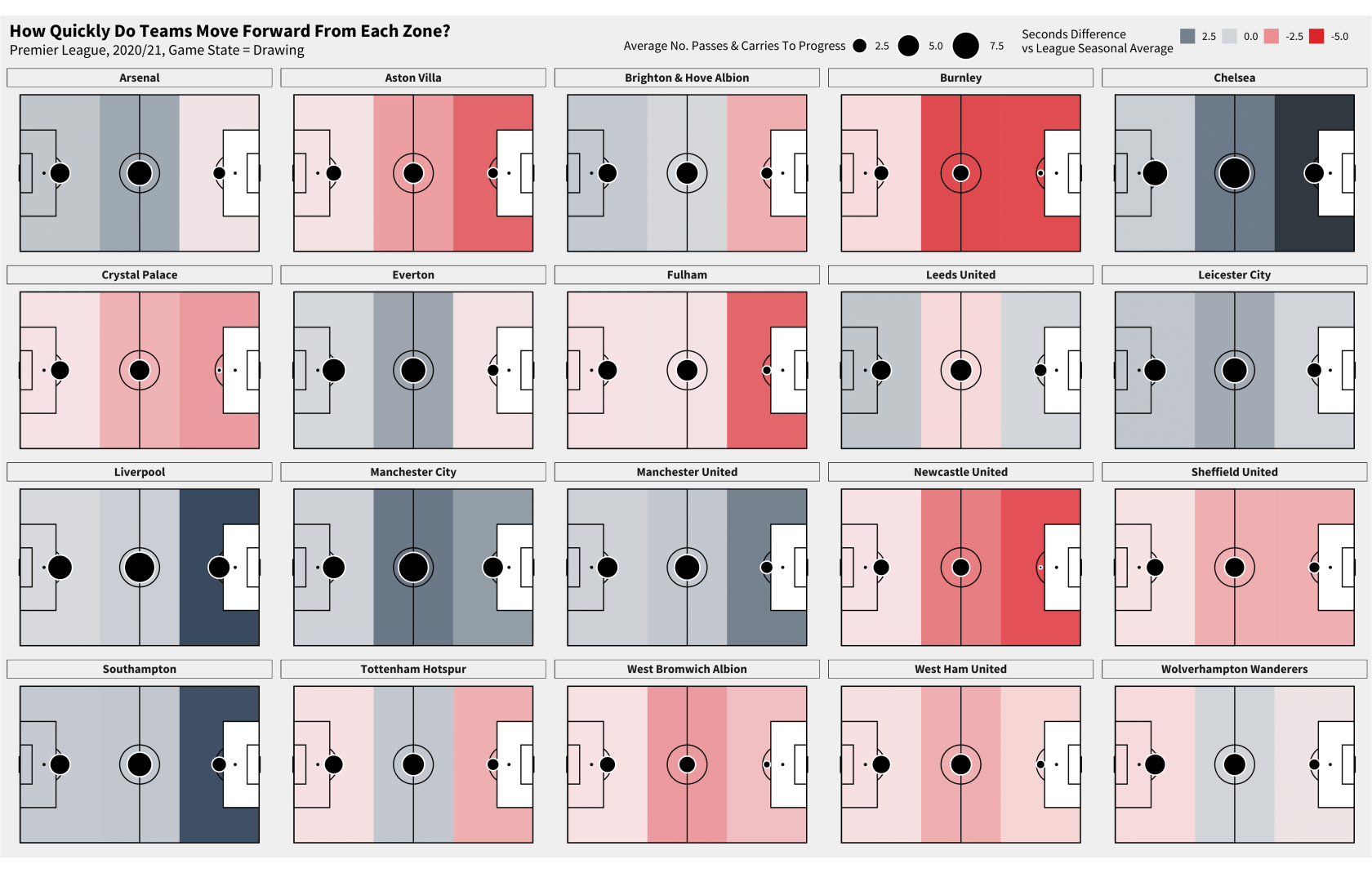
They play the long pass early and often in buildup, and with little prompting. On average they don’t play enough passes before the out ball to attract any sort of opposition pressure, and even when they do they’re unremarkable in terms of the amount of pressure put on them prior to the long pass. Whether they can manage a ‘attract pressure and play through it’ style is a moot point. They are mostly just avoiding the issue.
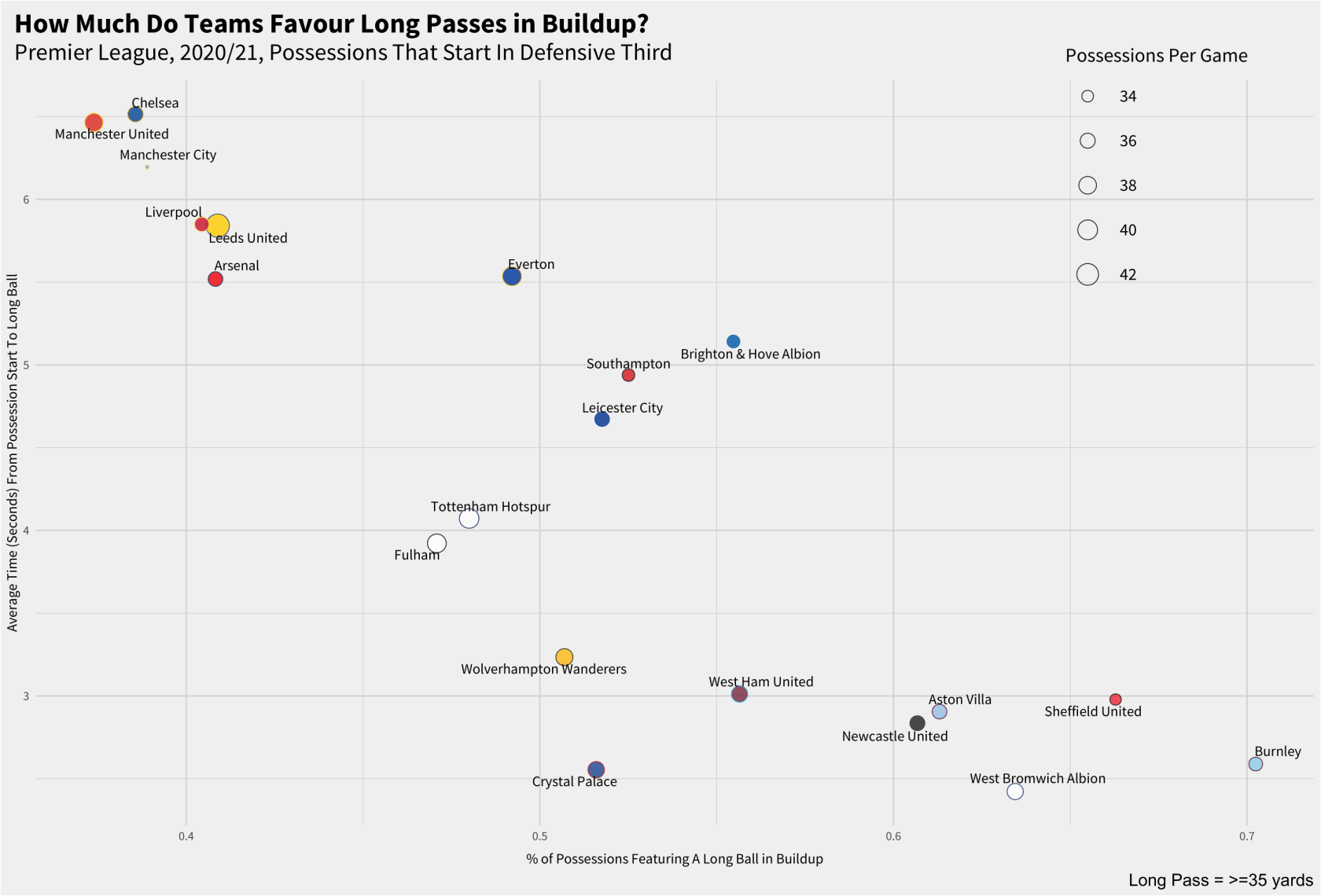
This isn’t a huge change from last season. They’re getting to the long pass a bit above two thirds of a second faster from the start of possessions, but the frequency is basically unchanged. What has changed is their effectiveness. They’re completing the initial pass at about the same rate but now they’re retaining the ball afterwards more often. This makes them the most effective of those ‘direct’ teams – look at them pull away from the pack here. It’s also worth noting that a low percentage of these passes (relative to other direct teams at least) are of the ‘high’ variety, often coming in at a lower height.
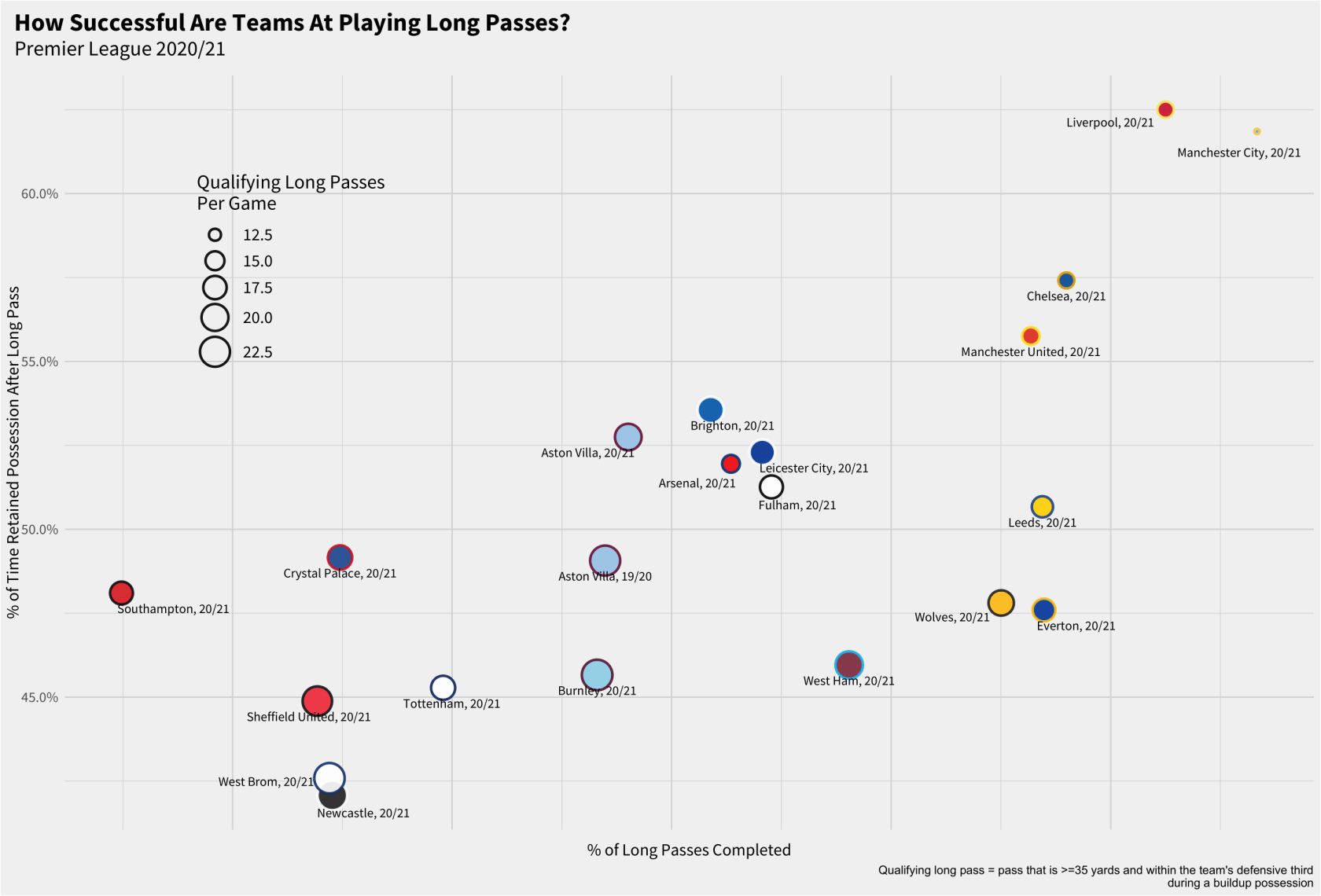
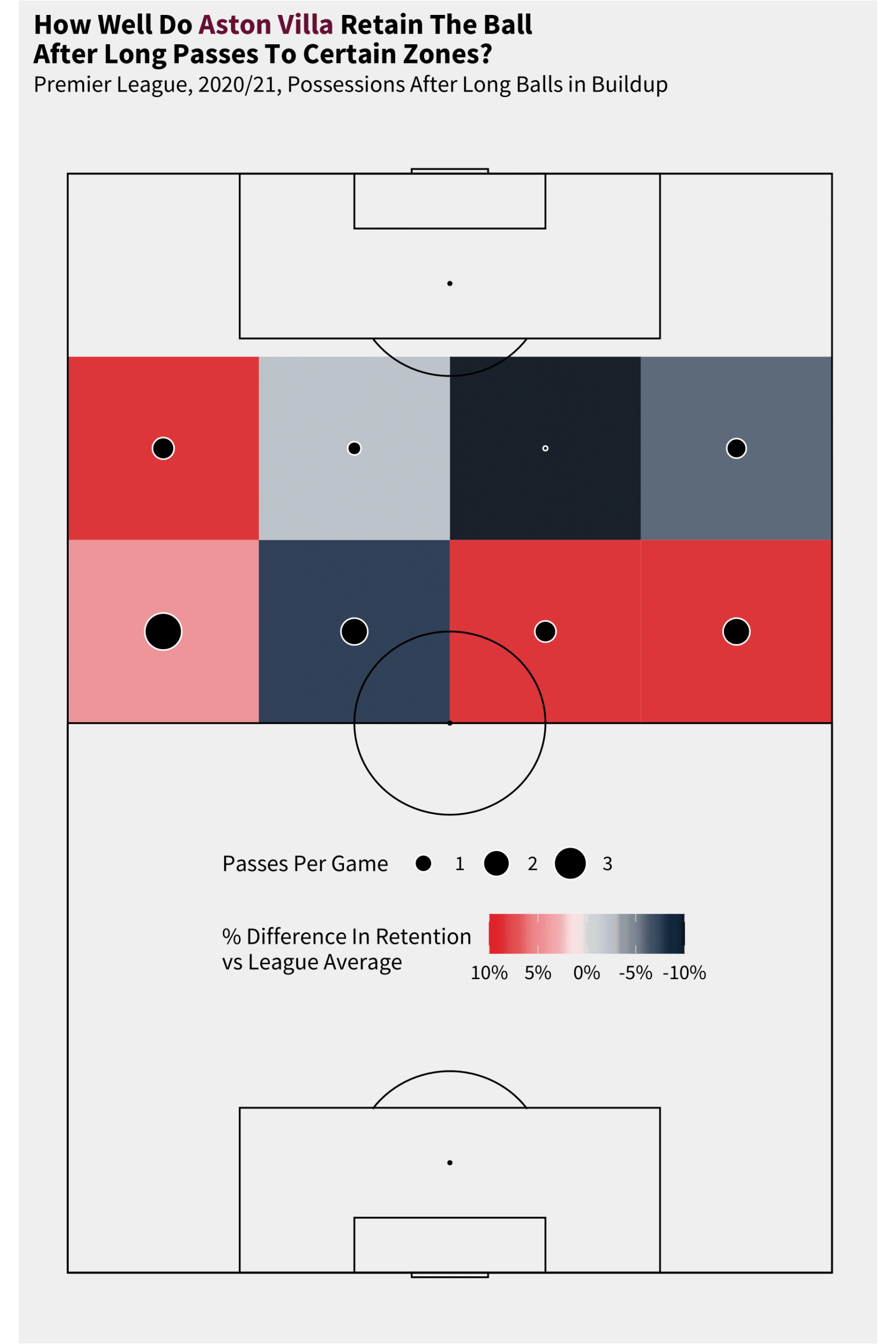
The two most common recipients of these out balls are striker Ollie Watkins (naturally) and Jack Grealish. Of these passes received, 50% of Watkins’ are high passes – a fairly low amount amongst strikers in the league – while only 26% of Grealish’ are high, marking him out as a more possession-orientated type of ‘hold-up’ player, receiving the ball to feet as either an outlet to relieve pressure or to turn and progress play. What’s interesting about Watkins’ receptions is that there’s a clear left-sided bias, both in terms of where the initial reception is and where he passes afterwards. Outside of a handful of games, that left side is where Grealish had spent most of his time playing. It’s all part of a serious skew towards getting Grealish on the ball as soon as possible.
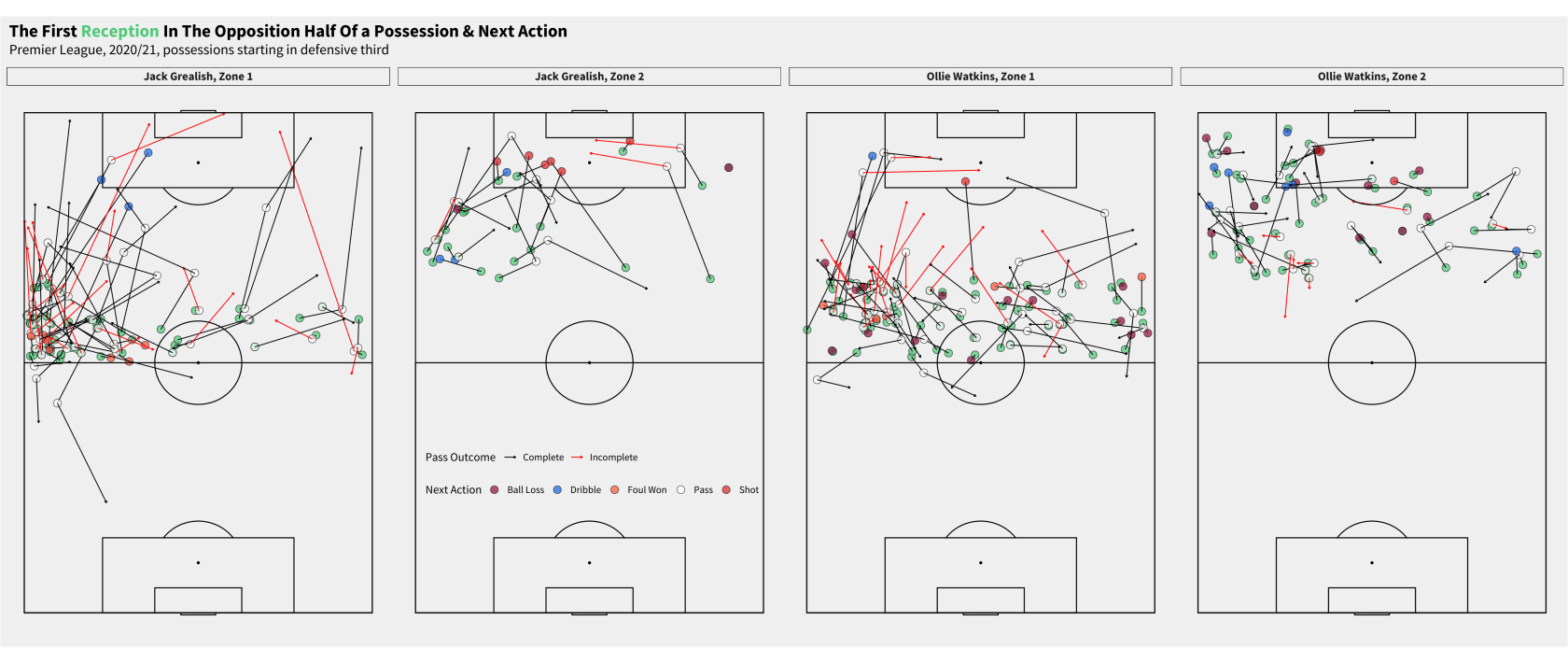
In the interest of making the point, let’s compare where and how early he receives the ball versus Villa’s two most used midfielders – Douglas Luiz and John McGinn. Generally, you’d expect your midfielders to be your go-tos in that second phase of possession, after the centre backs have moved it on. Luiz and McGinn are fulfilling that ‘drop between the centre backs’ role. Grealish, however, is dropping as deep as them, as early as them, despite being a nominal winger.
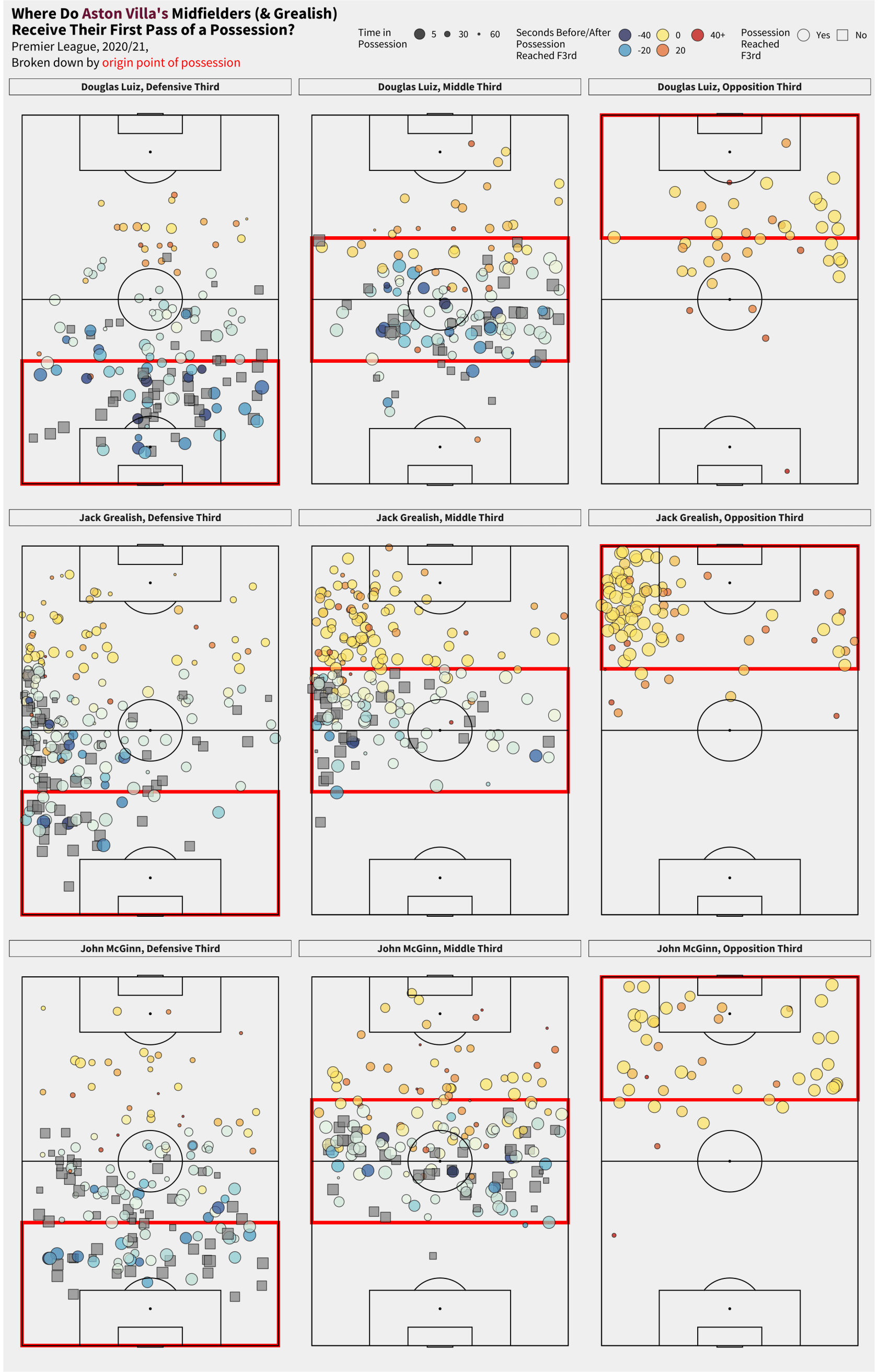
We can emphasise the overall strategy even further by looking into how Villa generally structure the beginning of their possessions. Here are the first six passes of Villa’s buildup possessions, broken down by the five most common pass clusters at that point in the possession. It almost prompts a chuckle just how clear the tilt is here towards getting Grealish on the ball. They start with that long goal kick, either direct to Grealish or to a forward player in Grealish’s vicinity for them to win and then get it to him. If they don’t go long they look to work it up that left side straight away, taking as direct a route as possible, even if they have to work it around at the back before doing so. That’s part of the fun with Villa – they are moving quickly but not always via long balls as much as just a laser-focus on quick forward movement, regardless of pass height. Those diagonals from right to left on the 6th pass are just the icing on the cake.
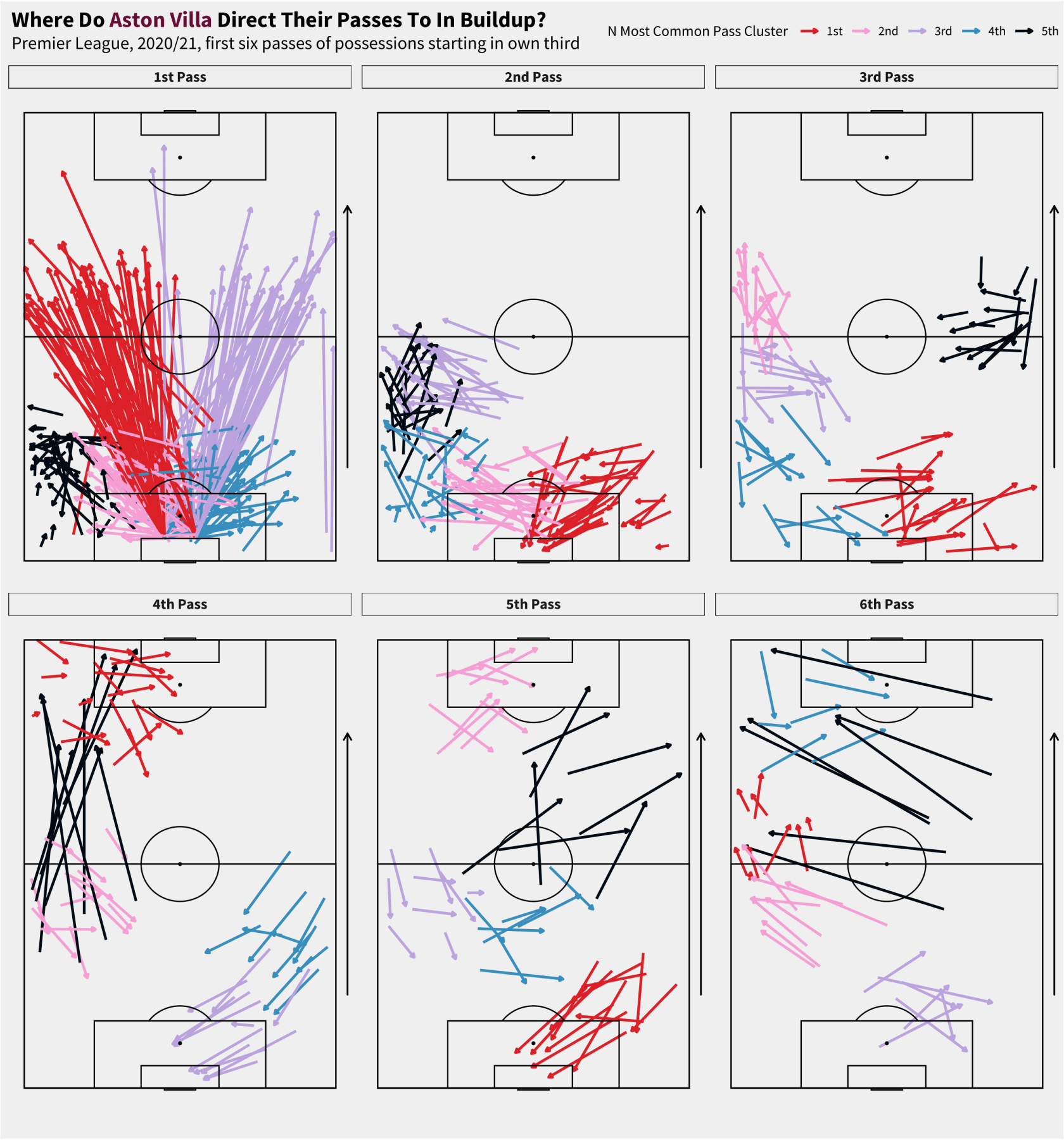
All in Villa have set themselves up very well for this style of play. The players they have in forward positions have a wonderful combination of technical skill plus roughhousing ability. Watkins, Grealish, Traoré et al can – to varying degrees – bring a long ball down with a light touch or hold off a defender with strength and balance, then slalom around challenges or win a cheeky foul. When they don’t win the initial confrontation or get on the end of that first pass, they never fail to hound the opposition, forcing them into clearing their lines or provoking a dodgy decision. The rest of the team are always ready to mop up, be it through compactness of shape putting them in position to clean up those clearances or just their nose for a loose ball. They aren’t afraid to let play turn into a bit of head tennis – they know they have it covered.
Once they’ve gotten the ball forward, they waste absolutely no time playing through their usual patterns. Look here how quickly they move it into Grealish and Matt Targett’s sweet spots on the left side for the ball into the box. This type of profile is quite unusual. For similarity between teams’ passing clusters, Villa this season come out as the team with the second biggest difference between them and their most similar team. It’s also notable how little sign of frequent breakthrough (or attempted breakthrough) there is on the right. It’s a less successful avenue. More on that later.
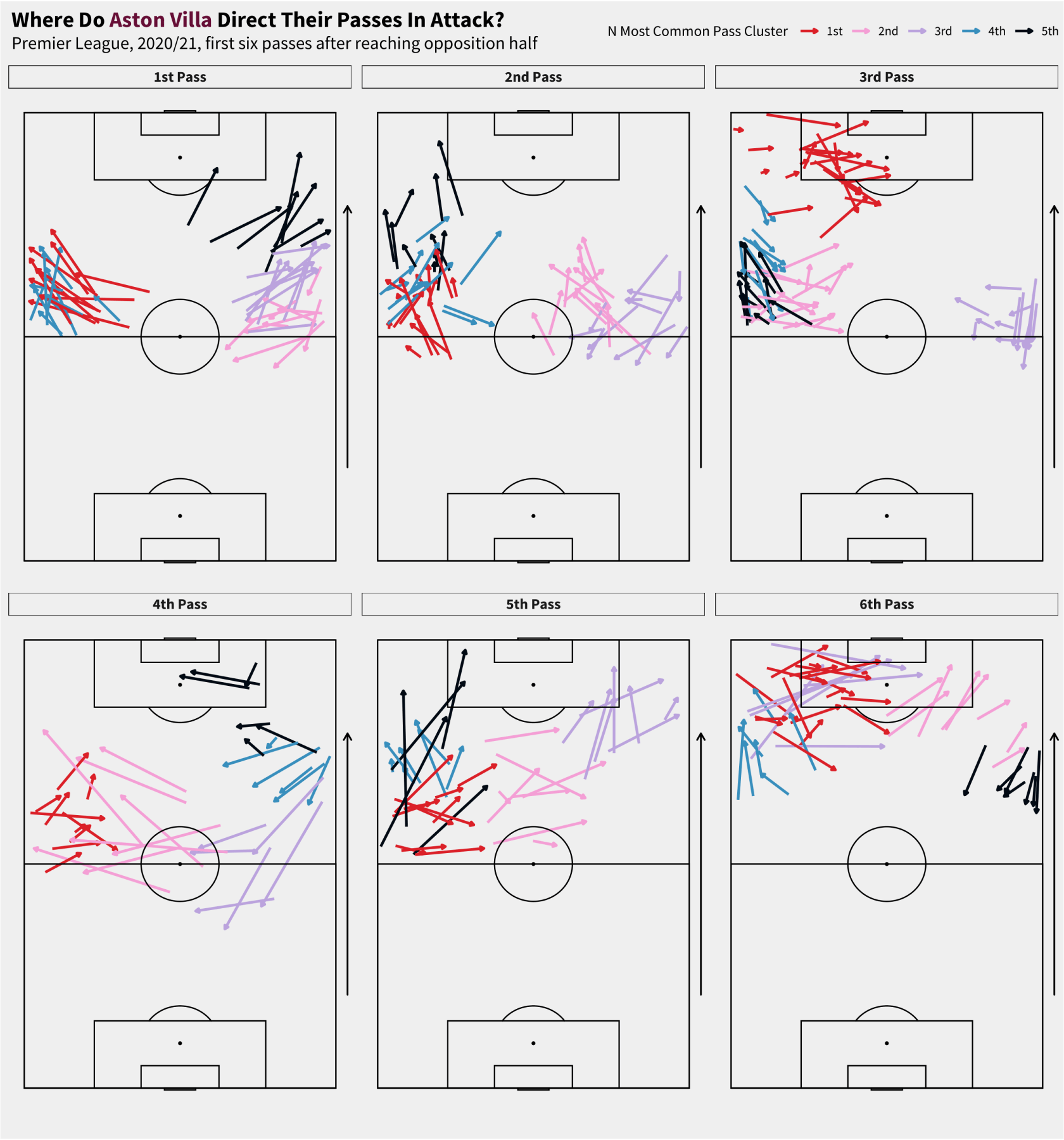
Grealish is carrying the load big time on this. Any sort of usage stat you can think of, Grealish is at or close to the top of it in terms of the load he carries. What particularly stands out is the amount of ball movement and shot creating and taking he’s doing in direct attacks, for a team who are built around such moves. He as the creator and Watkins as the finisher is the partnership that defines the team, everyone else has been filling in on the margins.
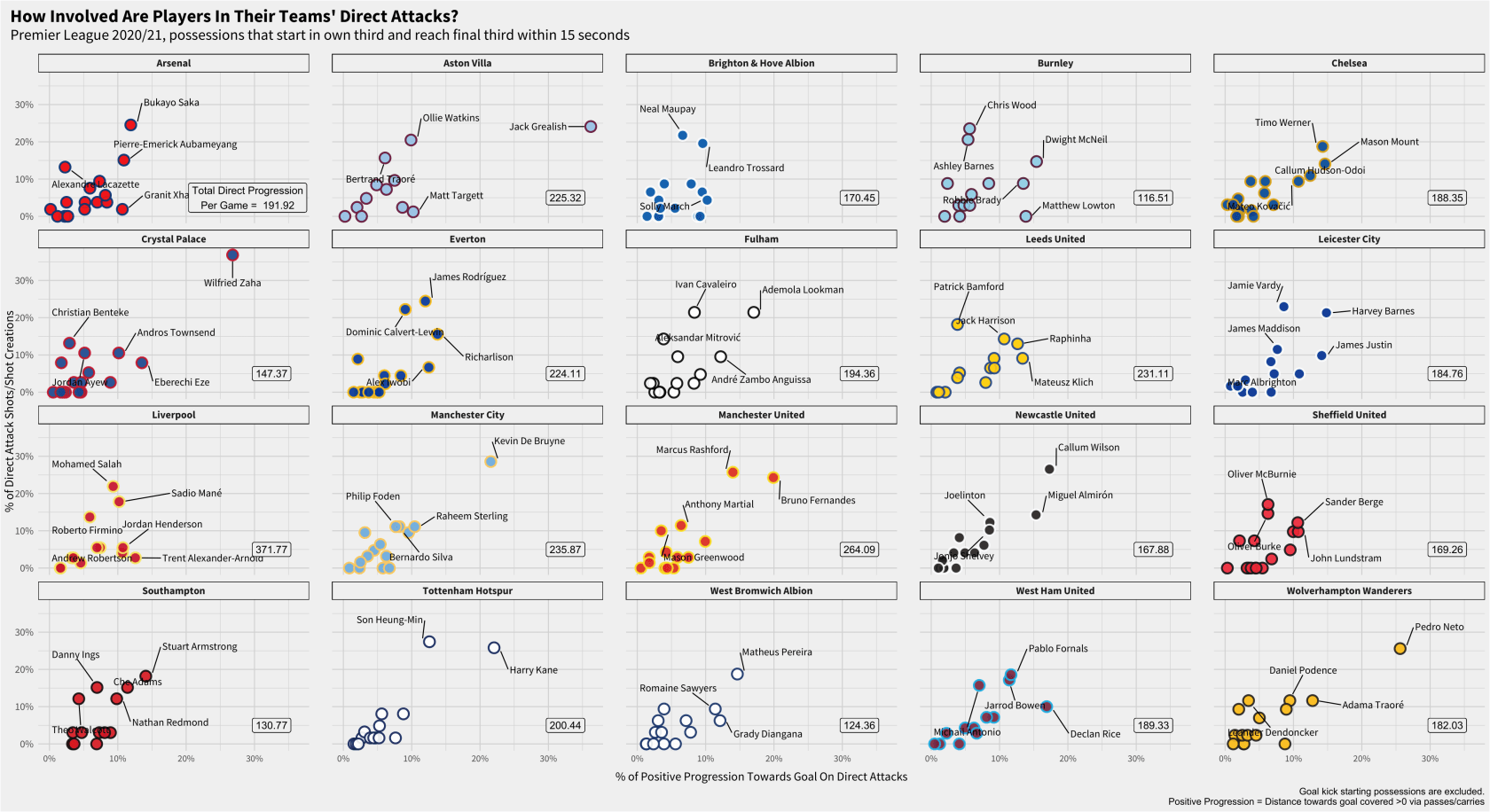
By visualising his more progressive passes and carries, broken down by the origin zone of the possession, you can see the quite silly things he’s doing. Particularly on the carrying the ball side. At times he is just a one-man ticket into the opposition’s danger areas while getting the absolute shit kicked out of him along the way (he is winning the most fouls in the league in any situation, and by some margin).
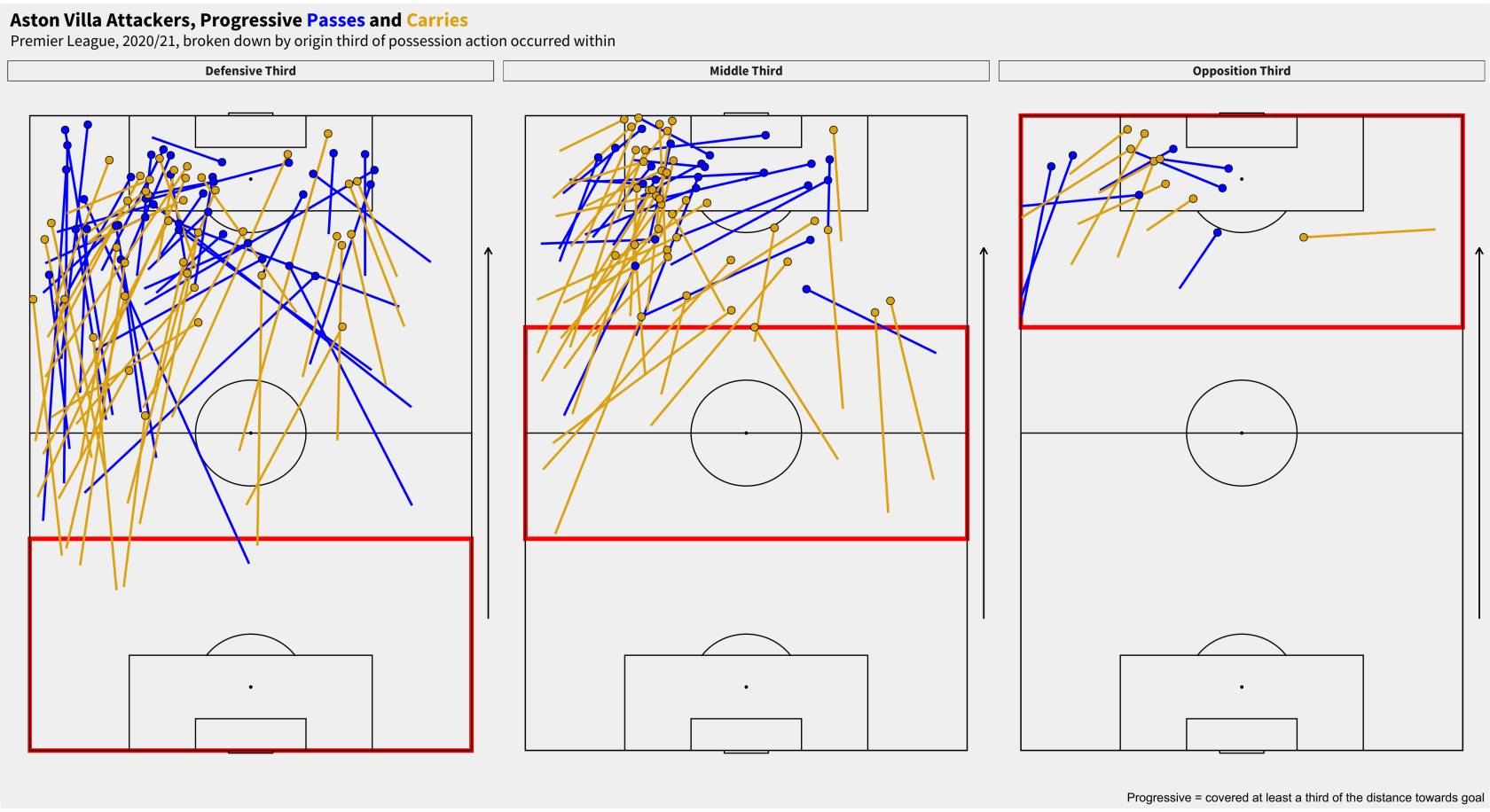
Looking at the more immediate chance creation numbers, the same story plays out: Grealish and Watkins are dominating the passing/chance-taking side respectively. The only other team who really comes close to having such an obvious reliance on two players like that is Tottenham, and even they don’t have that same sort of contrast where one is clearly a creator/not a goal threat and vice versa. Grealish, for all of the amazing things he is doing this season, has not developed beyond the ‘infrequently cut in from the wing and take a bad shot’ profile. But one thing at a time.
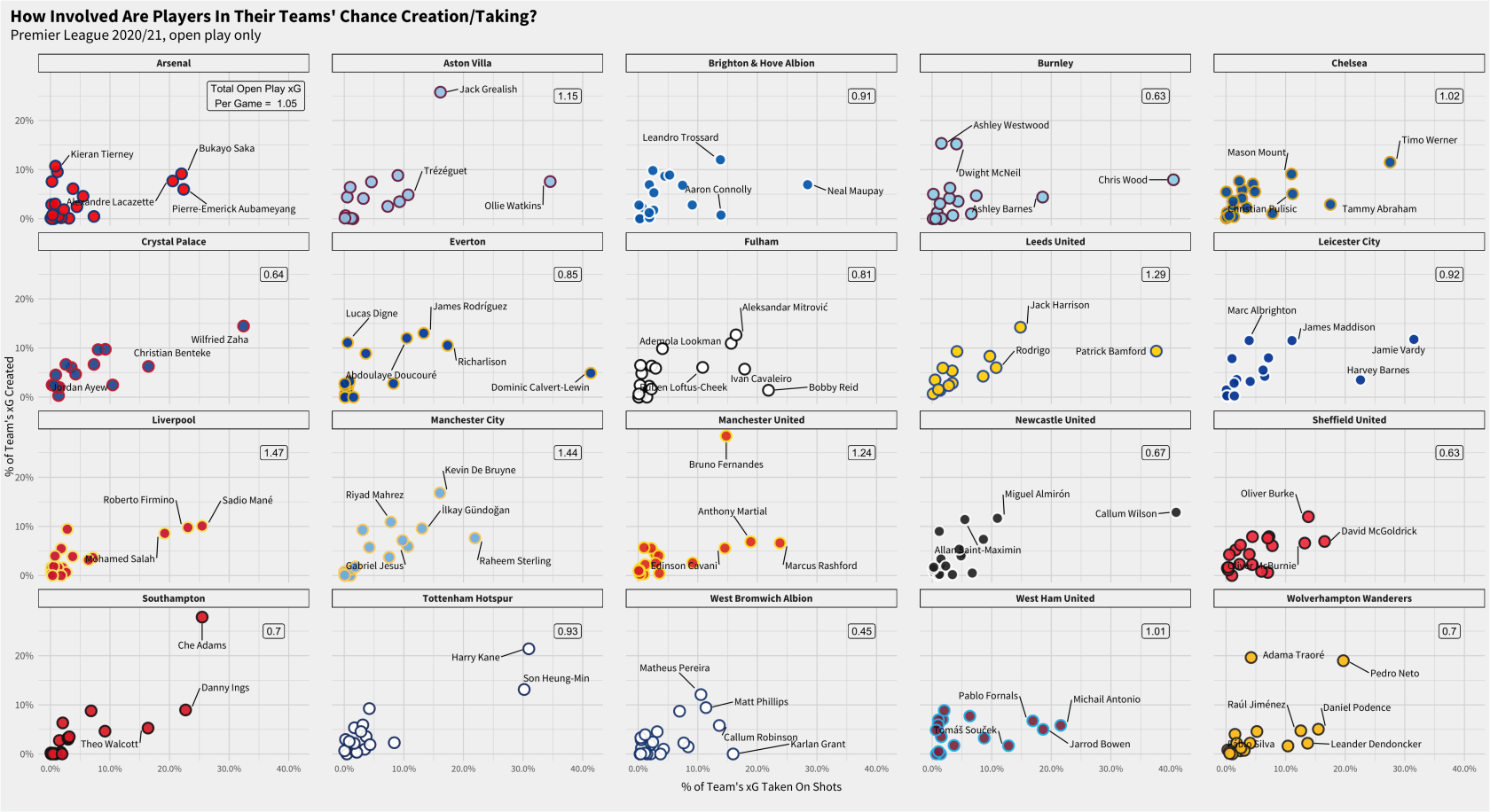
Not much of his chance creation is just simple ‘pick it up, put a ball into the mixer’ work. Often times he’s having to actually get a bit of forward movement going before picking out a teammate. His spell as an attacking mid for a few games also showed he’s capable of operating in more compacted spaces with his tricky touches, although it probably does make him even more attractive a fouling target (If you would like to see the equivalent chart for Ross Barkley, please check this article’s post script).
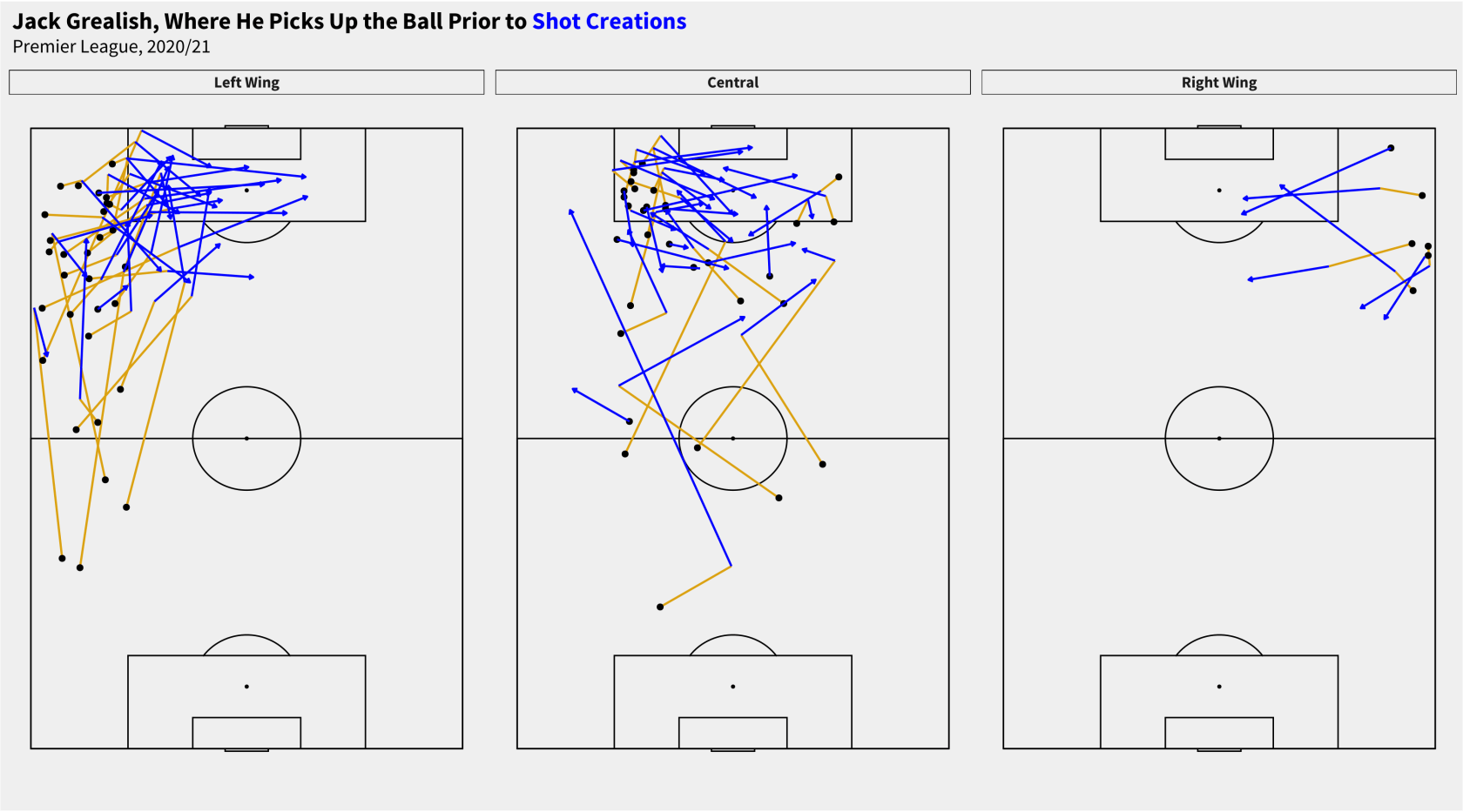
Finding contribution from the non-Grealish members of the three attackers behind Watkins has been tricky. Right-sided winger Trézéguet has been more of a hard-working, ‘gets on the end of attacks’ style of player but he’s benefitting seriously from a couple of passes/shots inflating his xG created/taken numbers in his reduced playing time. He has so little in the way of progressive ball movement that it wasn’t even worth putting him on that visualisation, god bless him. Bertrand Traoré has more about him in that regard with a few nice mazy, man-beating jaunts up the pitch, and can create shots for himself more readily. Great shots they are not though, and his creation for others doesn’t stack up to Grealish at all. That leaves the ever divisive Ross Barkley, who has been extremely Barkley-esque in his in his first season as full-time attacking midfielder since his Everton days. He can thread through nice passes from that number 10 spot and has already built up a healthy rapport with his fellow attackers. But, you know, at 27-years-old you’re locked into a certain player with him at this point. The iffy shot choices, the alternating between brilliant dribbles through the middle of the pitch and losing the ball in bizarre ways – it’s all part of the Ross experience.

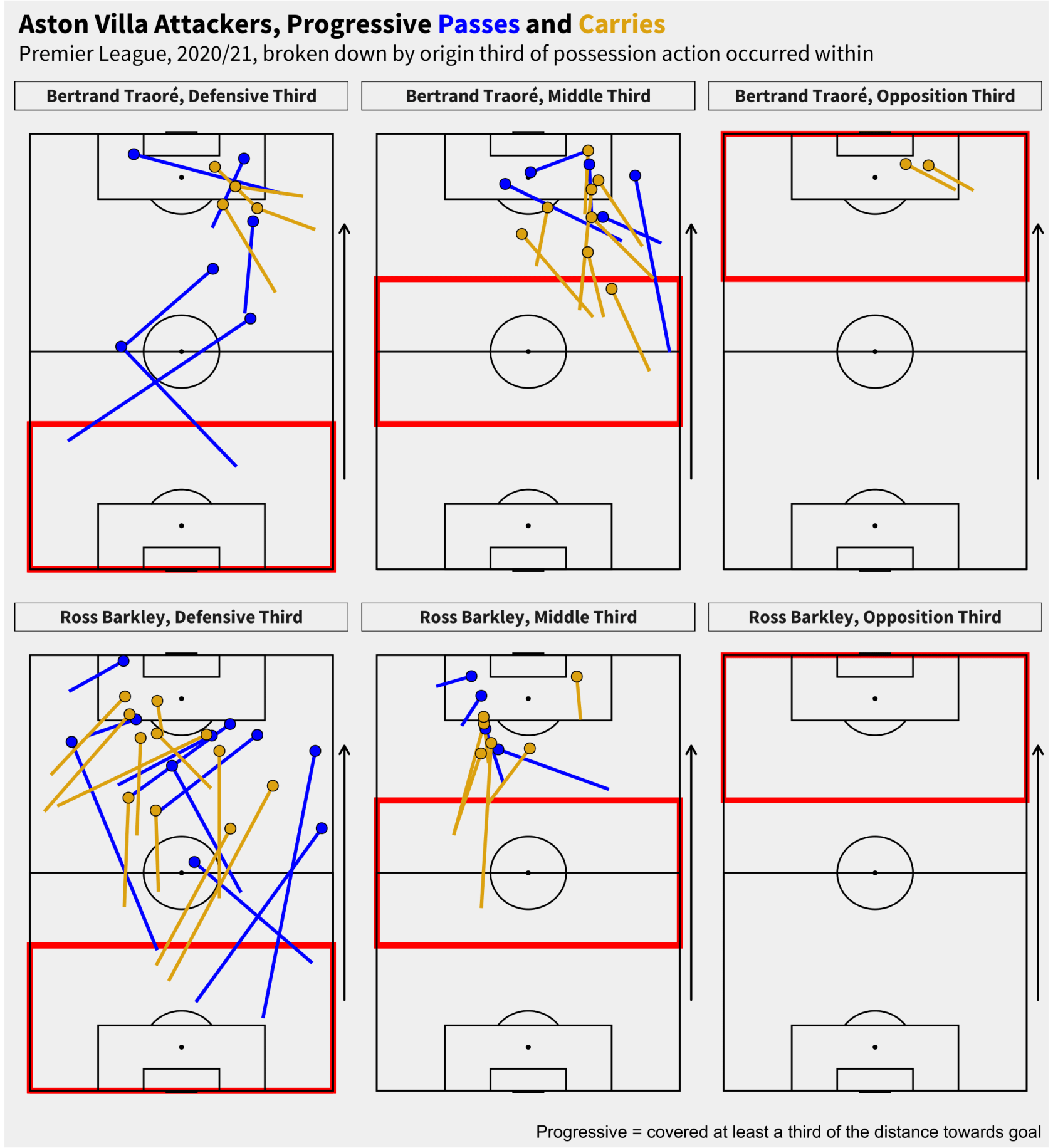
A lot of on-ball responsibility falls upon the midfielders Douglas Luiz and John McGinn. Luiz is the defensive midfielder and his passing mostly reflects what you’d expect from that profile – again, dropping deep and shifting the ball on to the full backs/wingers/his midfield partner as a part of the usual rhythm of play. McGinn is the more adventurous of the two, willing to uncork a bold pass and-where possible-generally being more forward thinking.

As noted though, Villa thrive in frenzied situations, so it pays to dig further into how these two move the ball in the direct aftermath of regaining the ball. Here we’re looking at passes after ball recoveries/tackles won and so on. The key takeaway here is the middle third selection – how both Luiz and McGinn regain the ball in that zone and are often immediately looking for some sort of longer pass out to either a wide option (again, going out wide to progress from there!) or just more directly forward. McGinn has also helped relieve some of that Grealish load with progressive passes.
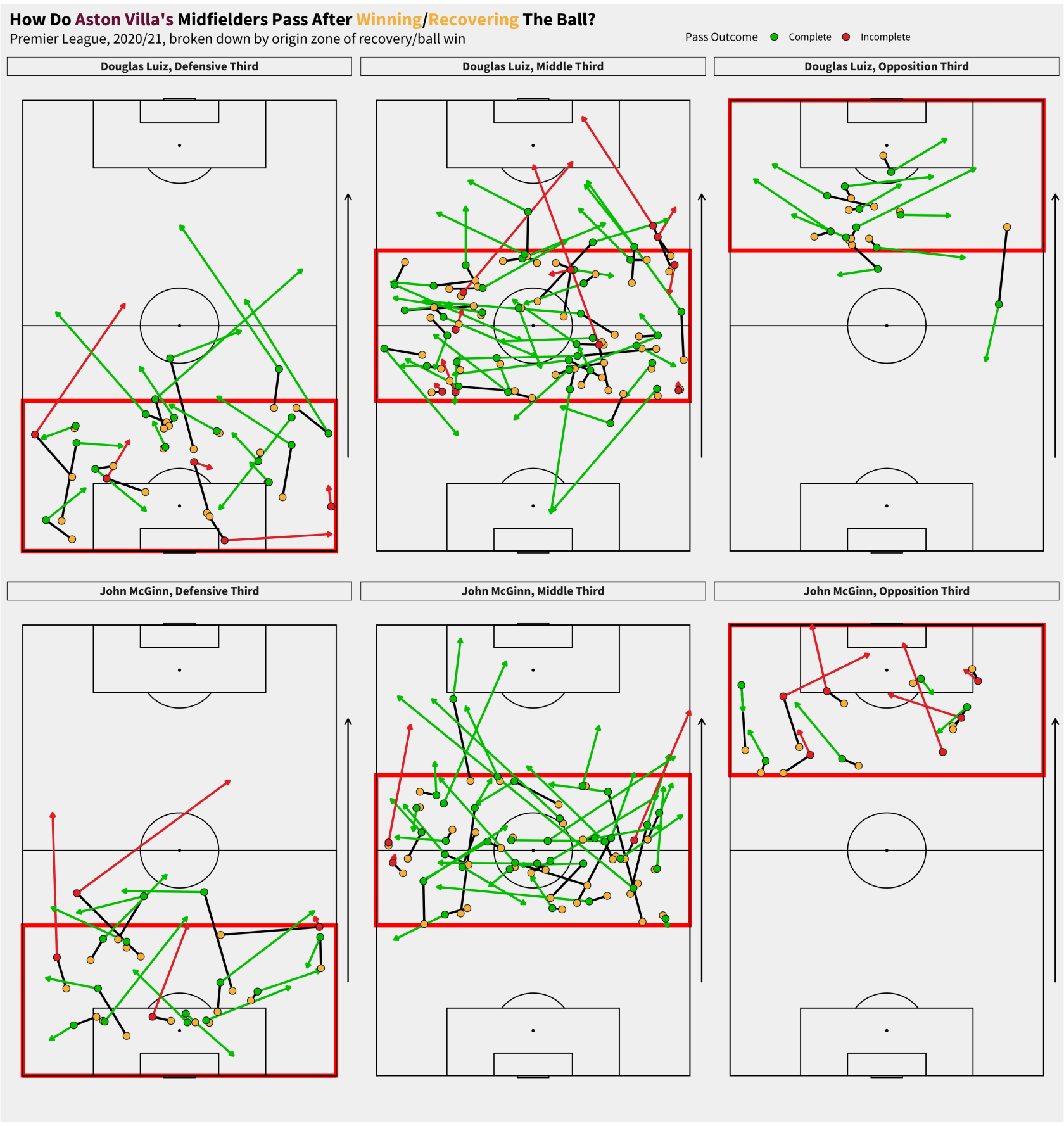
McGinn’s role extends to being one of the league’s most press-resistant players in the centre of the pitch. Not only is he just generally helping out with his slippery dribbling abilities (1.44 dribbles completed per 90 and 2.88 fouls won, 11th and 1st respectively amongst midfielders) he is often receiving with his back to pressure and dealing with it really well, retaining the ball and even progressing it back up the pitch at times. (If you would like to see the equivalent charts for Grealish, please check this article’s post script. Spoilers: he is an outlier).
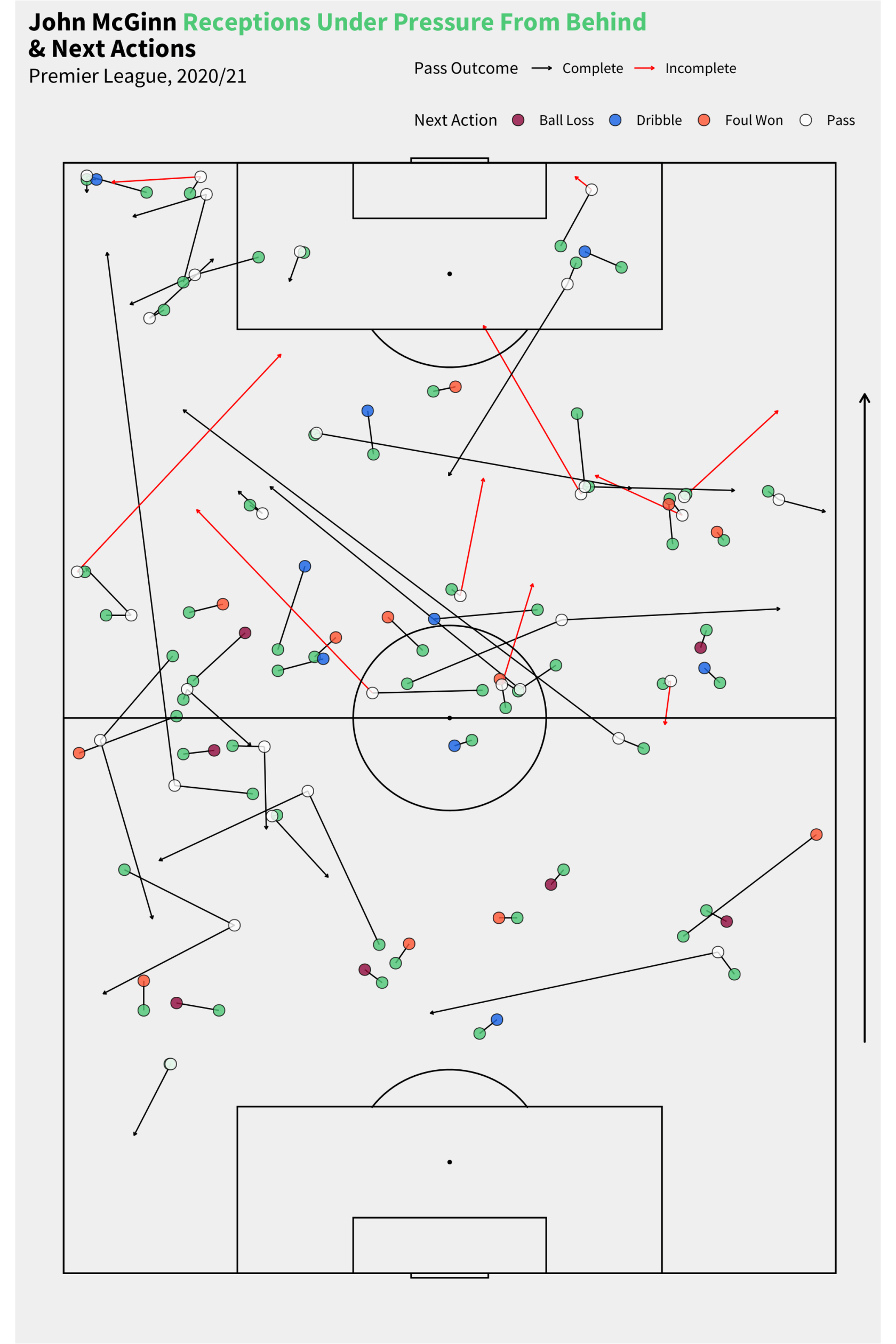
It isn’t the most complicated style but they’re implementing it far more successfully than most teams and certainly than their own attempts last season: 20% of their final third entering possessions were counters in 2019/20 (3rd in the league) and that’s only shifted to 18% this season (now 1st in the league). The difference is they’re now way more productive in these circumstances, creating 46 shots on the counter this season already vs 43 last season total. This also accounts for a greater proportion of their overall shots – 25% and 1st in the league this season vs 16%/9th last season.
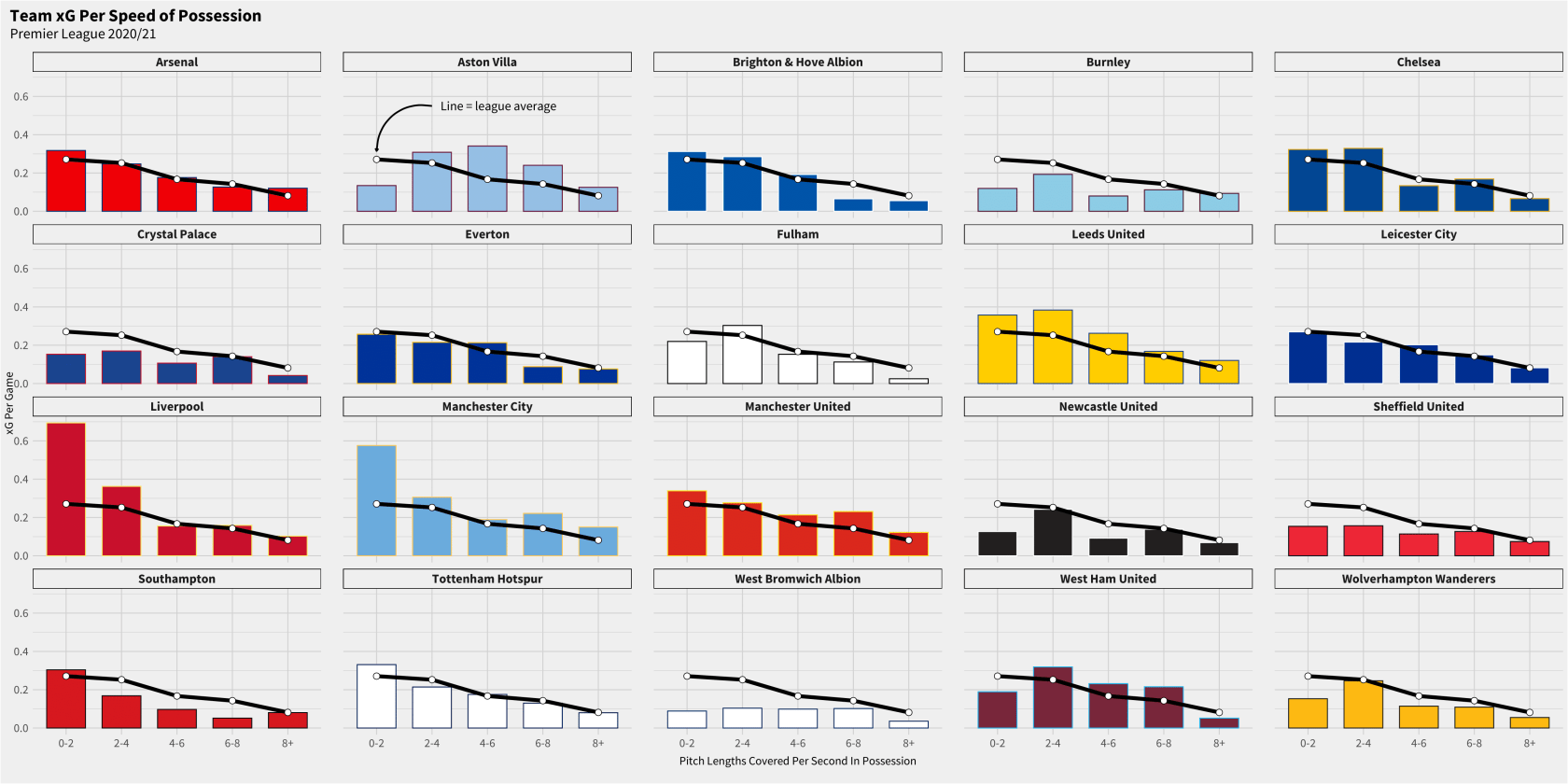
They’ve also accompanied this rise in volume with an uptick in shot quality. Last season they were just dreadful in that regard, with their 0.083 open xG per shot being second worst in the league. This season it’s upped to 0.106, only mid-table relative to the rest of the league but plenty fine for a team with such volume. The speed of their movement has really helped with getting them shots in situations where opposition defences are all discombobulated. They’d be even better if it weren’t for shakier shot-taking decisions of some of their attackers (look at that big grey zone on the left side of the box where Grealish hangs out).
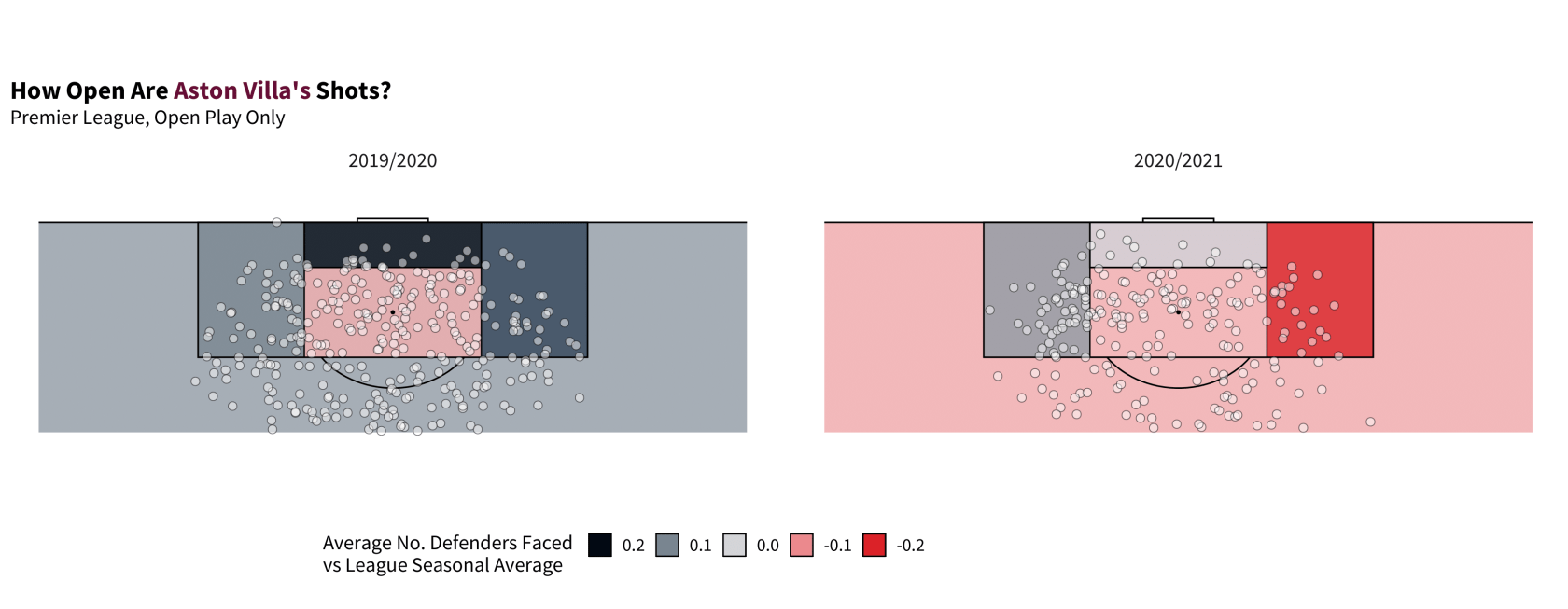
Aside from Grealish’s obvious heroics, this improvement can in large part be attributed to the change up front. Villa’s strikers last season were Mbwana Samatta (now playing in Turkey) and their dubious summer 2019 signing Wesley (still with Villa, has not played a single minute for them this season due to injury). Adding in Watkins – bought from Brentford where he had been spearheading their attack for the last couple seasons – has been a big boost. He’s currently 6th amongst all PL players in terms of xG per 90 (4th if we take it down to just consistent starters), on a combination of both good shot volume and quality. The lad possesses a great knack for darting into/out of a defender’s blindside at the last second, getting to the ball before them. He’s a great partner for Grealish and we saw earlier his contributions in holdup play from those long balls Villa favour. It also helps that he hasn’t missed a single mintute of (league) football so far, starting and finishing every game.
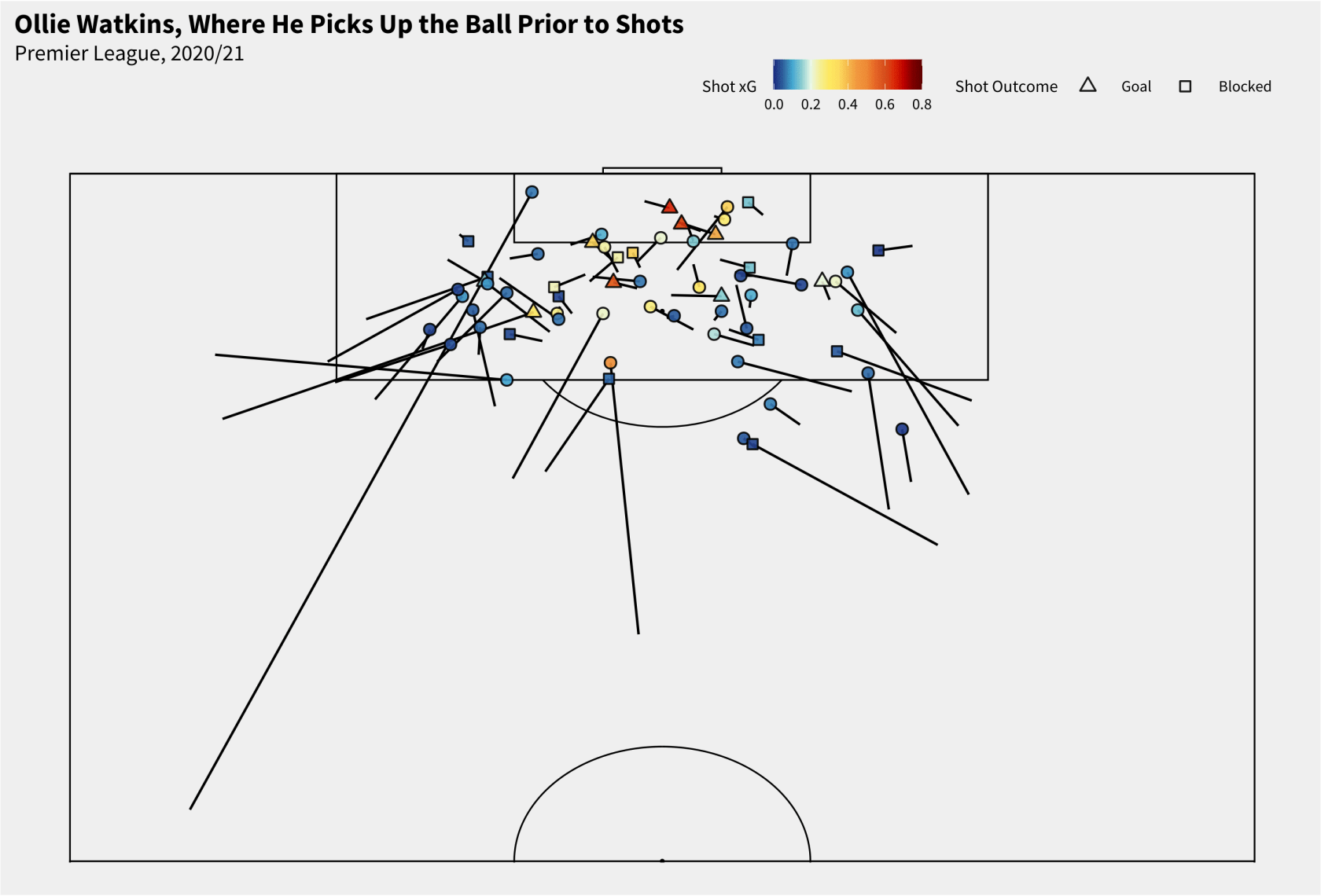
His weakness lies in some unnecessary cruft in his shot profile. He has a tendency to move out wide, particularly in transition and on the left wing. In some ways this is a good trait of his – having width as you’re moving the ball quickly up the pitch helps stretch defensive lines and it’s useful to stay out of the way of runs your teammates are making, to cut down on redundancy in that respect and again create difficult decisions for defenders. The issue is his decision making when he picks the ball up out there. He’s got some shiftiness on the ball, can cut in sharply and has strength hold markers off, but these aren’t his best attributes and it seems he overestimates what he can do in these situations. Too many times he just doesn’t work much space at all for a shot yet takes one anyway, inevitably finding it blocked. It’s less of an issue in really open transition attacks, as the space is already there. The same tendencies can sometimes also be seen when he picks the ball up outside the box. He seems to have quite a nice understanding with his fellow attackers – especially Grealish – so it’d be nice to see him cut down on the wonky shooting decisions and use these opportunities to link up with them more often. Or, hell, just make more striker-y runs through the middle.
Villa’s defensive solidity has also seen an improvement, just not to the same extent. Last season they were giving up almost 16 shots per game, the worst in the league. This season they’ve cut that to 13 shots, a still-not-great 13th in the league, but no longer just a clear disaster zone. Unlike the attack, which had a clear before/after shift from last season to this, the defence started improving at the end of last season, but it’s maintained that improvement for different reasons heading into 2020/21. At the back end of 2019/20 they were easing up defensively, backing off opponents even more in an attempt to limit the damage. Now that’s starting to trend in the opposite direction.
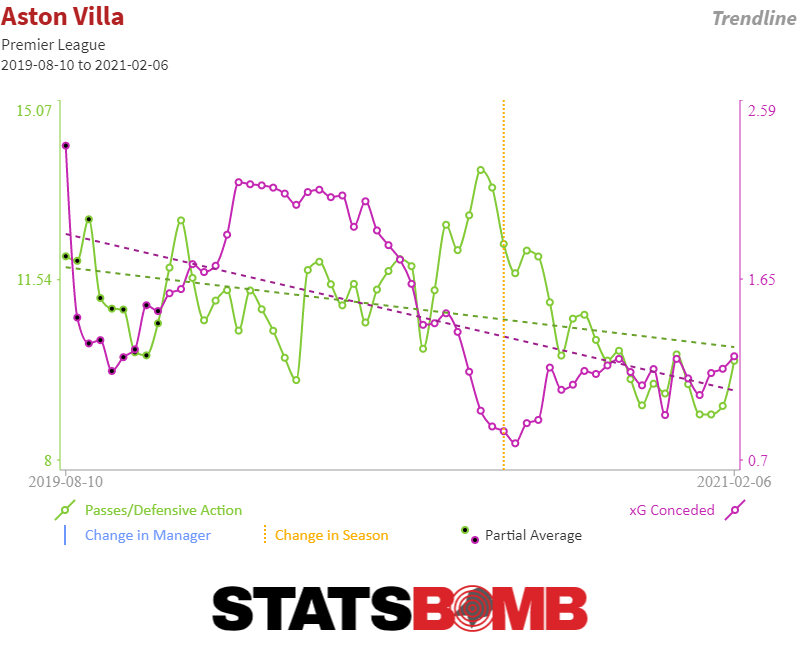
Embracing the chaos seems to be the thought here. If there’s going to be a direct element to your game, with plenty of opportunities for head tennis between you and your opponent, putting them in awkward situations, why not get aggressive and in their face whenever you lose the ball? This – along with their improved ball retention after long passes – is really helping out the defence, simply by meaning they have less work to do. 49% of their opposition’s completed passes came within Villa’s own half last season, 3rd most in the league. This season that’s been cut to 39%, the 6th lowest percentage.
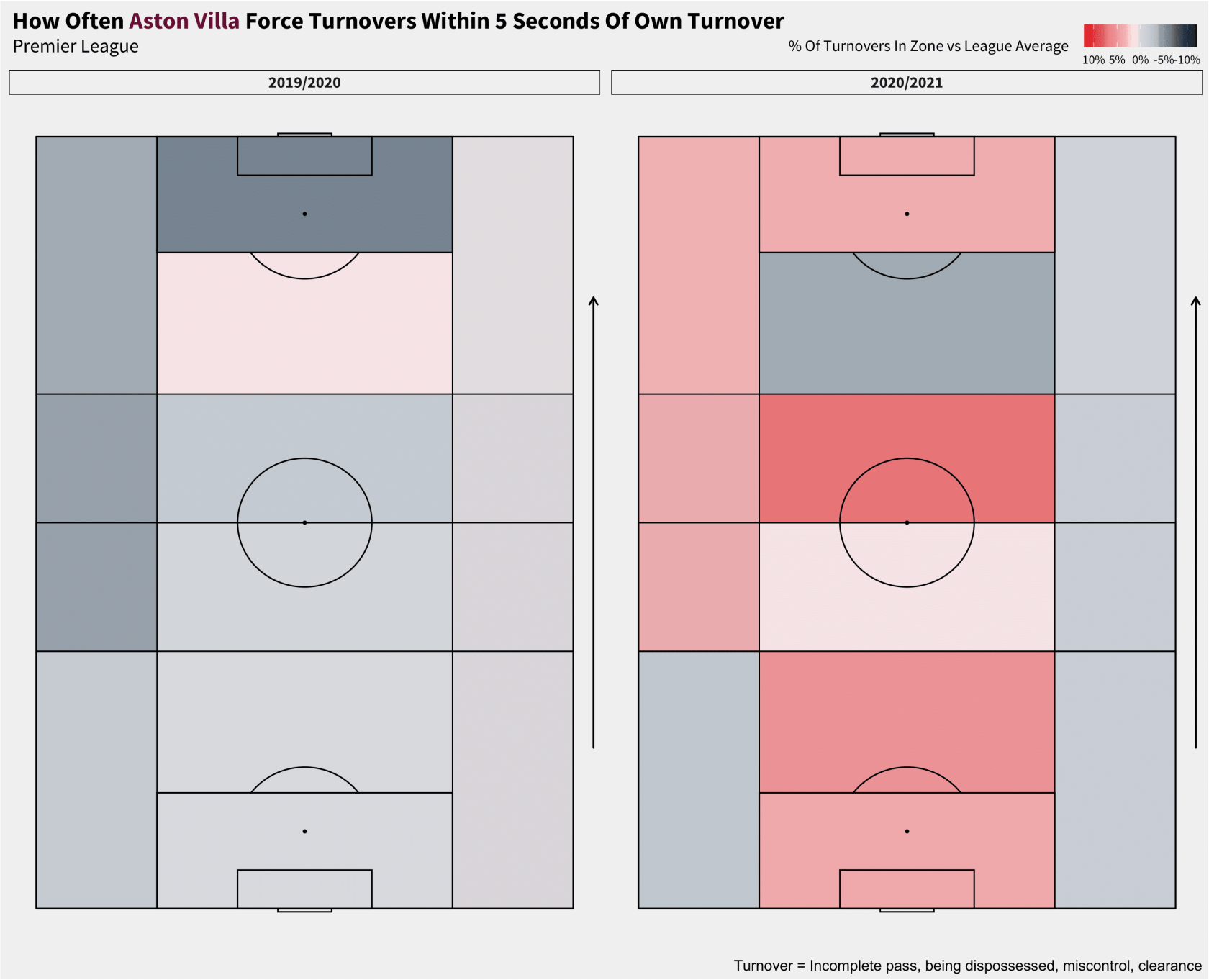
That same back-and-forth nature has its tradeoffs on the defensive end. Villa’s midfielders – particularly Luiz and particularly McGinn – are not at all afraid to venture out of their comfort area and interchange with others. Having Barkley as an attacking midfielder rather than a central one is certainly going to be better for your defensive forecast than the opposite, but his veering wildly between not tracking runners at all and tracking them as a sort of Rooney-at-his-worst-esque headless chicken ‘I will tackle this man and foul him’ is not a great match for two midfielders who are liable to leave holes.
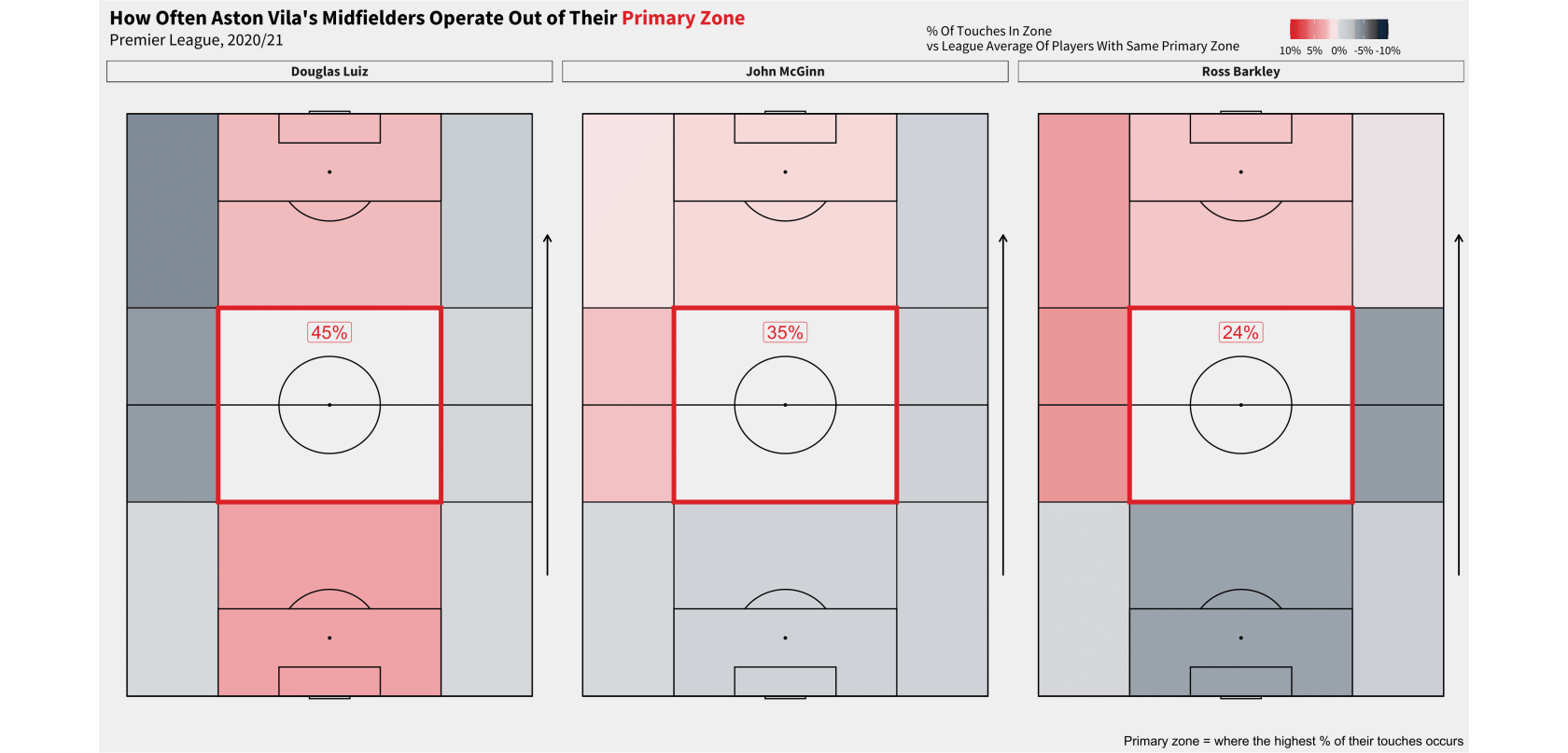
Their full backs – both handily called Matt – are not actually that attacking. Targett is the more obviously adventurous of the two, attempting to get on the end of a few back post crosses in the box and making some overlapping runs. But neither is zooming forward like they’re Andy Robertson or Ben Chilwell. More often they operate very clearly as a deeper, backup option to their respective wingers in terms of where the rest of the team looks when moving up the pitch.
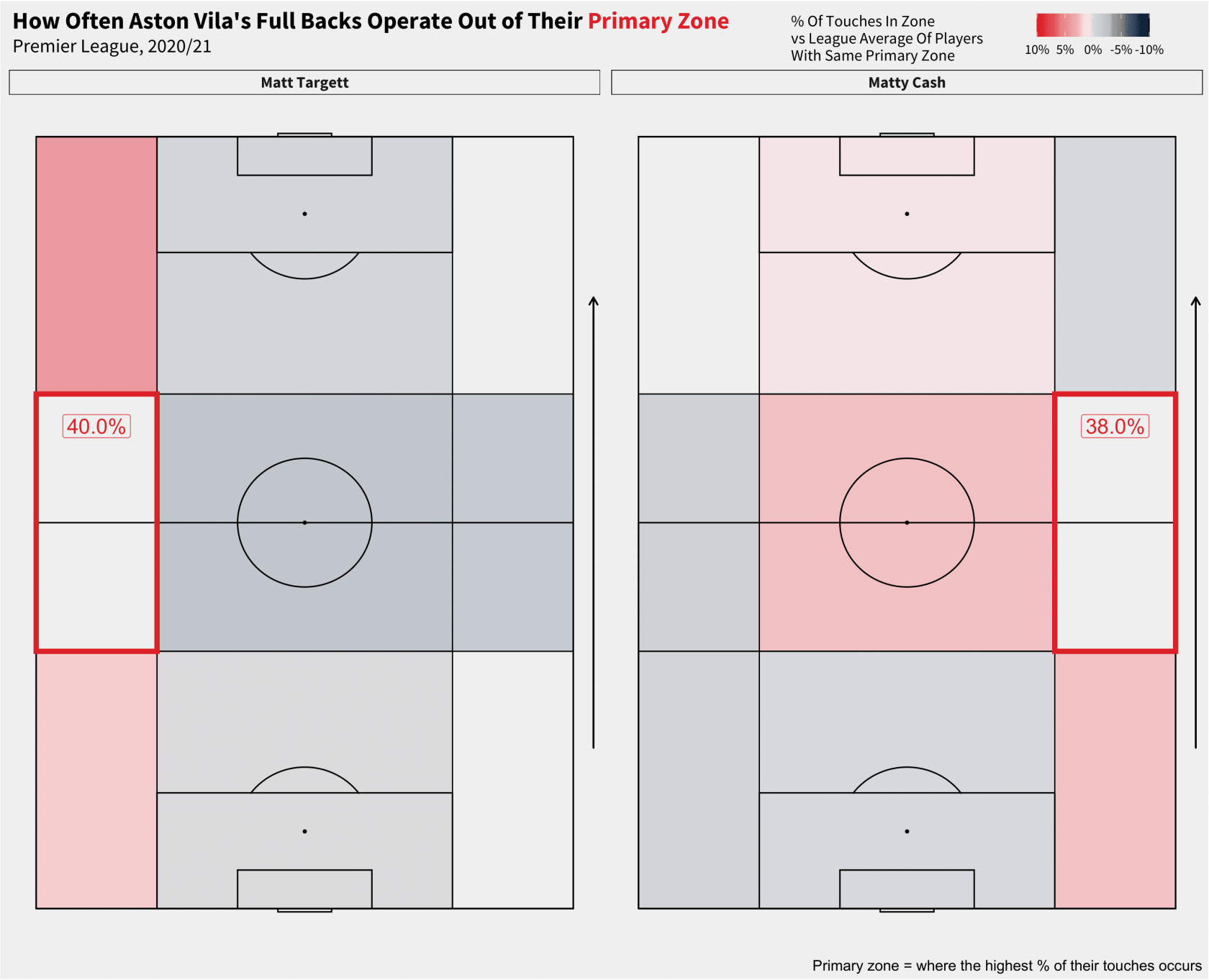
Nor do either of the pair bear a particularly large creative burden. Certainly not from traditional crossing positions. That space on the wings is filled by the interchanging attackers.
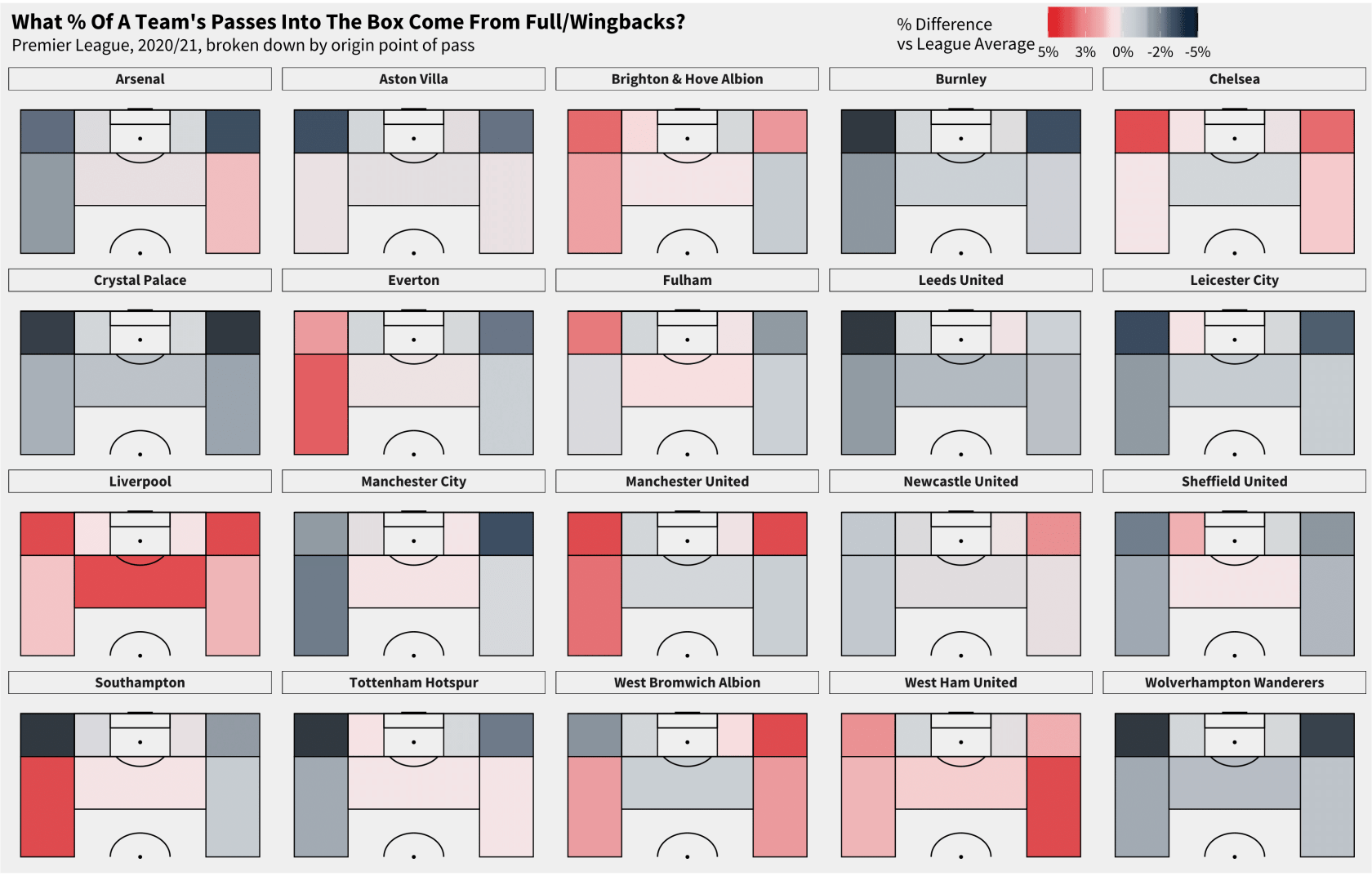
Their overall adjustments in style of play mean it can be hard to get into established possession against Villa, but those same tendencies mean it is now much easier to move through them or get in behind their high defensive line when you get the chance. They have the profile of a typical ‘run through our midfield’ team this season, whereas last season they were more bunker-y. Both due to how they chose to approach games and, well, their own inability to get the ball out of their own half in order to actually be vulnerable to transitions.
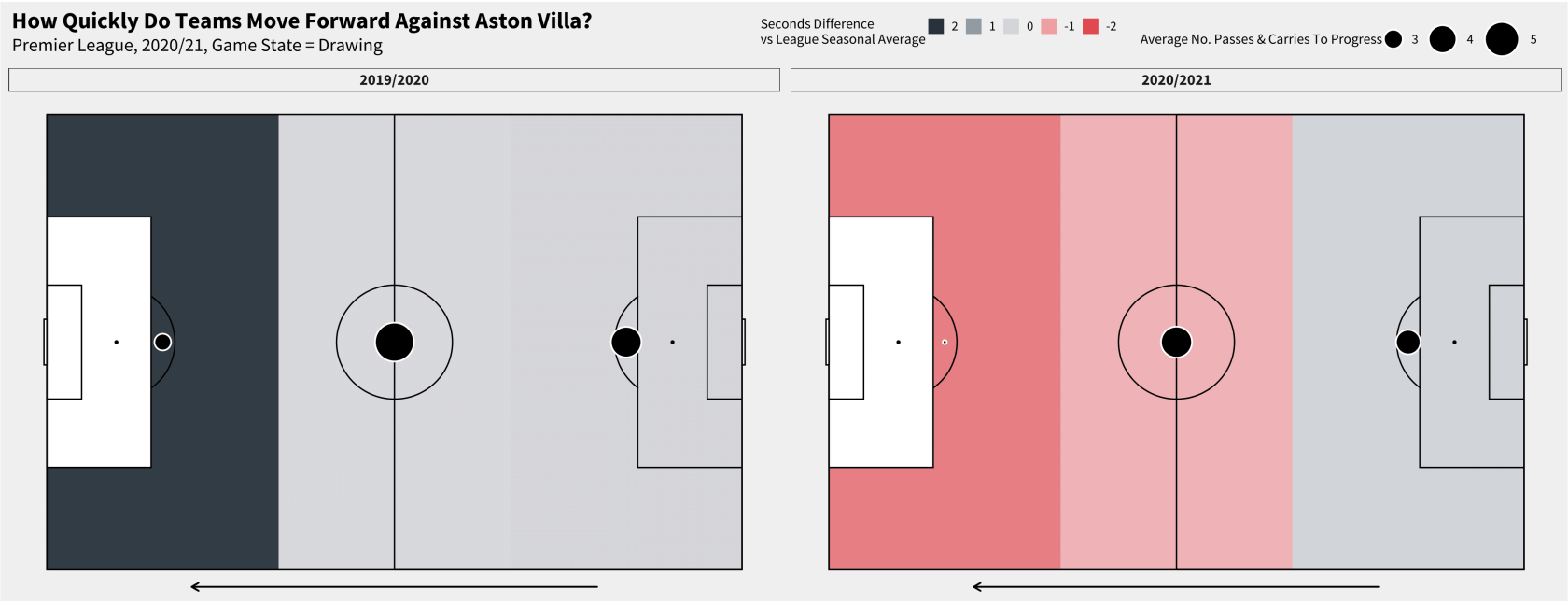
They also have an acute vulnerability to quick horizontal movement.
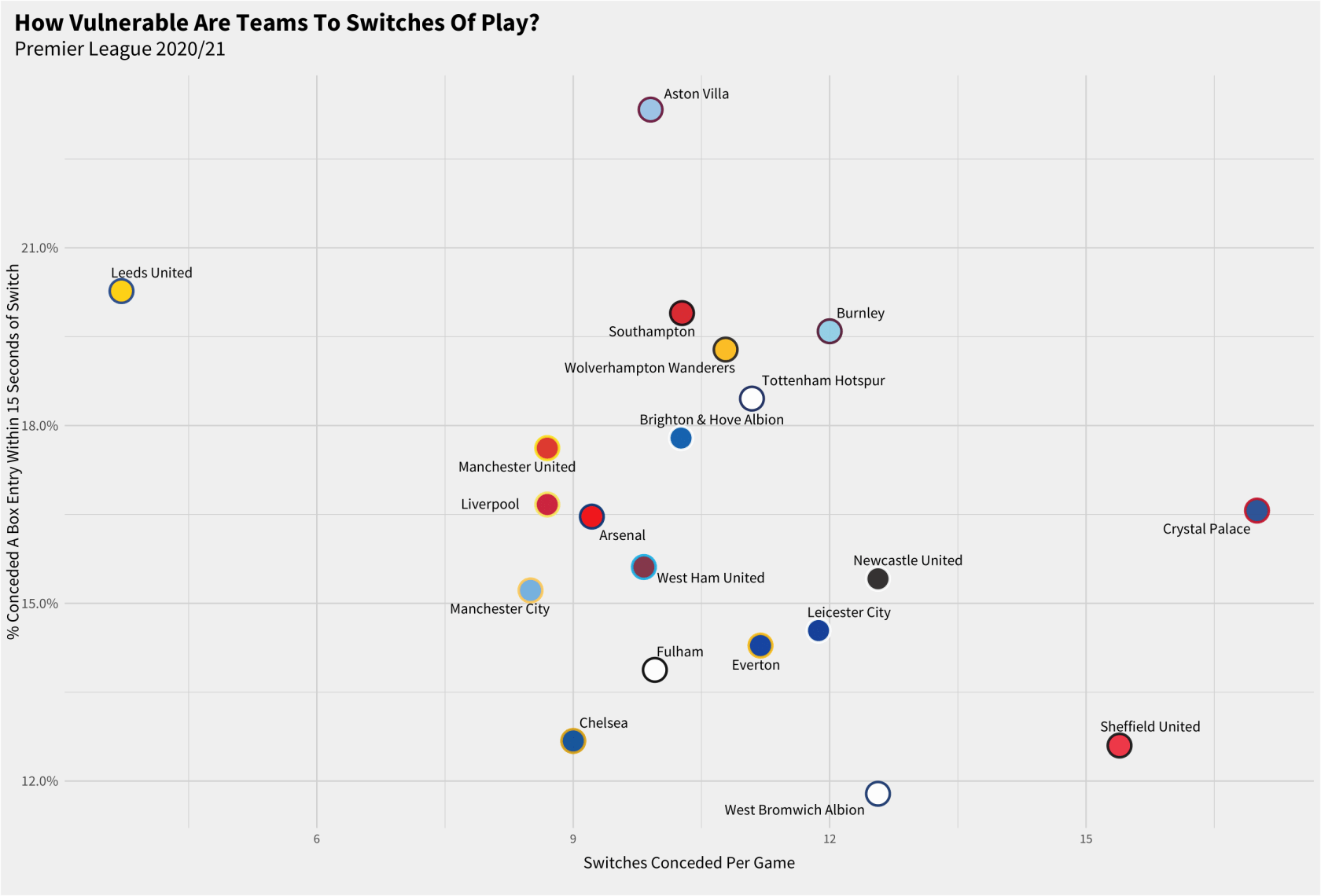
To some extent though this is again about tradeoffs. It seems, as noted previously, in some situations the fullbacks have been instructed to stay narrower out of possession and not go super wild while in possession. To sit tight and offer cover after losing the ball. We can see this on the chart below, looking at where fullbacks generally are known to have been before their team loses the ball. Villa’s full backs don’t stand out in advanced areas. They seem to intend to, again, offer cover and force wider players into less dangerous options. It’s notable that 38% of the passes into the box they’ve allowed are crosses, the second highest percentage in the league this season. If you have to give up something, crosses aren’t a bad option. Goalkeeper Emiliano Martínez is one of the most aggressive (and successful) at coming out to collect crosses in the league, dovetailing perfectly with this.
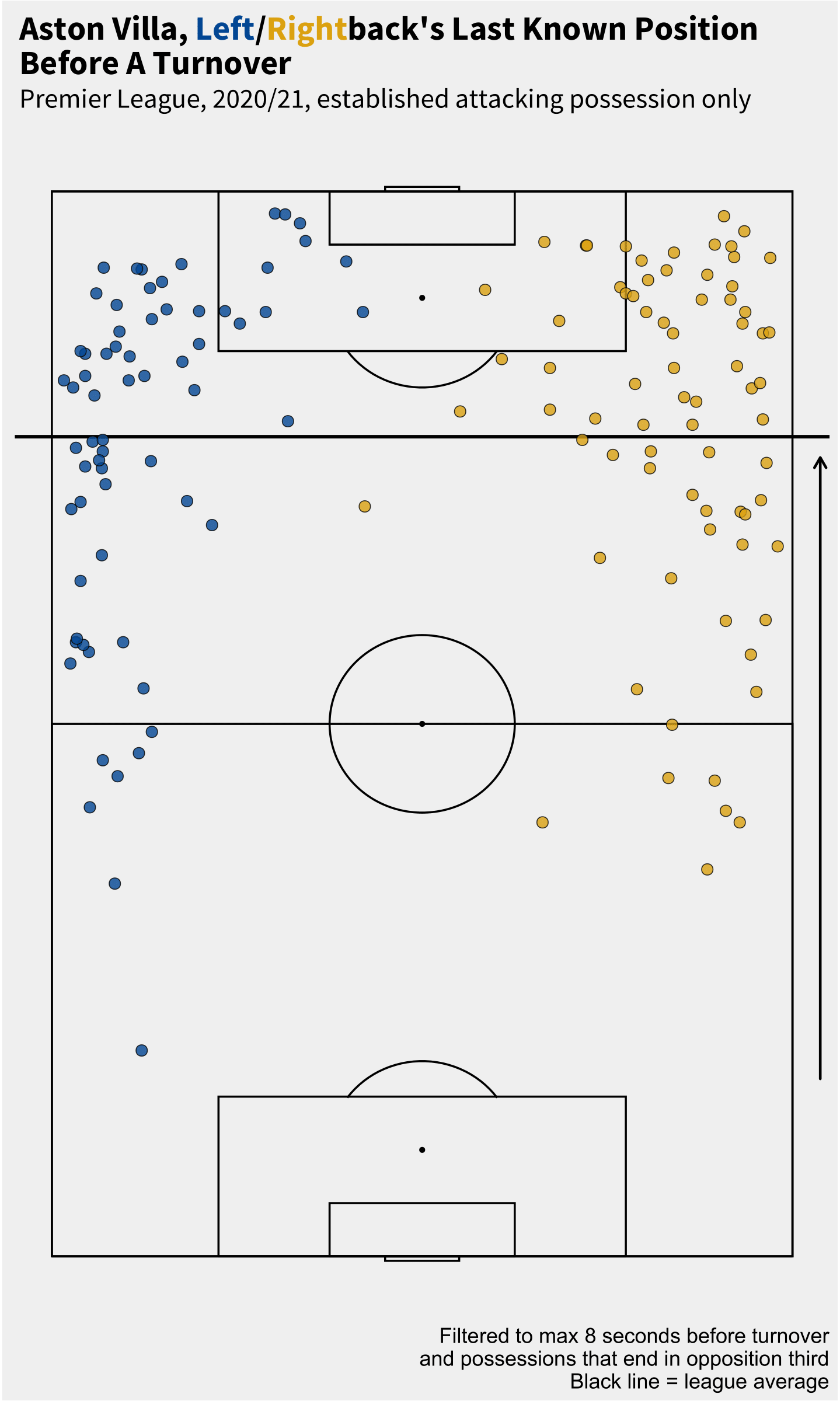
This really helps with limiting the kinds of shots opponents get when Villa’s shape falls apart. Note on the below viz how a) opponents just aren’t getting in dangerous areas that often this season, especially the six-yard-box (the fewest open play shots in the six-yard-box allowed in the league this season, versus the most allowed last season!), and b) they’re still doing a good job of getting defenders in front of shots despite no longer being a strict bunker team. Particularly on those wide shots. That’s a recipe for that dip in xG per shot we saw earlier.
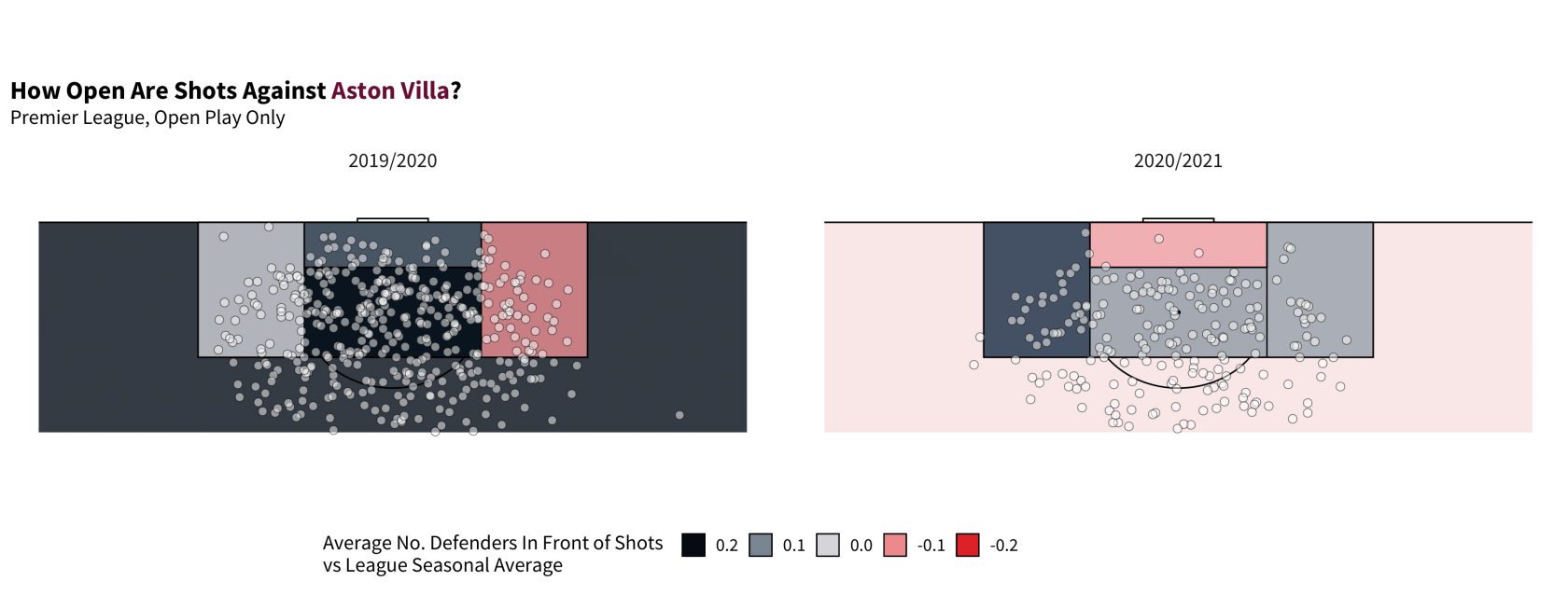
The upshot though is that the team’s overall hectic style – especially with their midfield opening up quite often – results in them still giving a lot of opportunities for the opponent to attack. They end being relatively hefty on giving up chances in the faster buildup speed ranges, beyond your very slow possessions. Certainly compared to other ‘good’ teams such as your Man Citys, your Liverpools etc. It’s not that bad though, definitely not quite to the extent of a Leeds United. Open play xG conceded is 9th best.
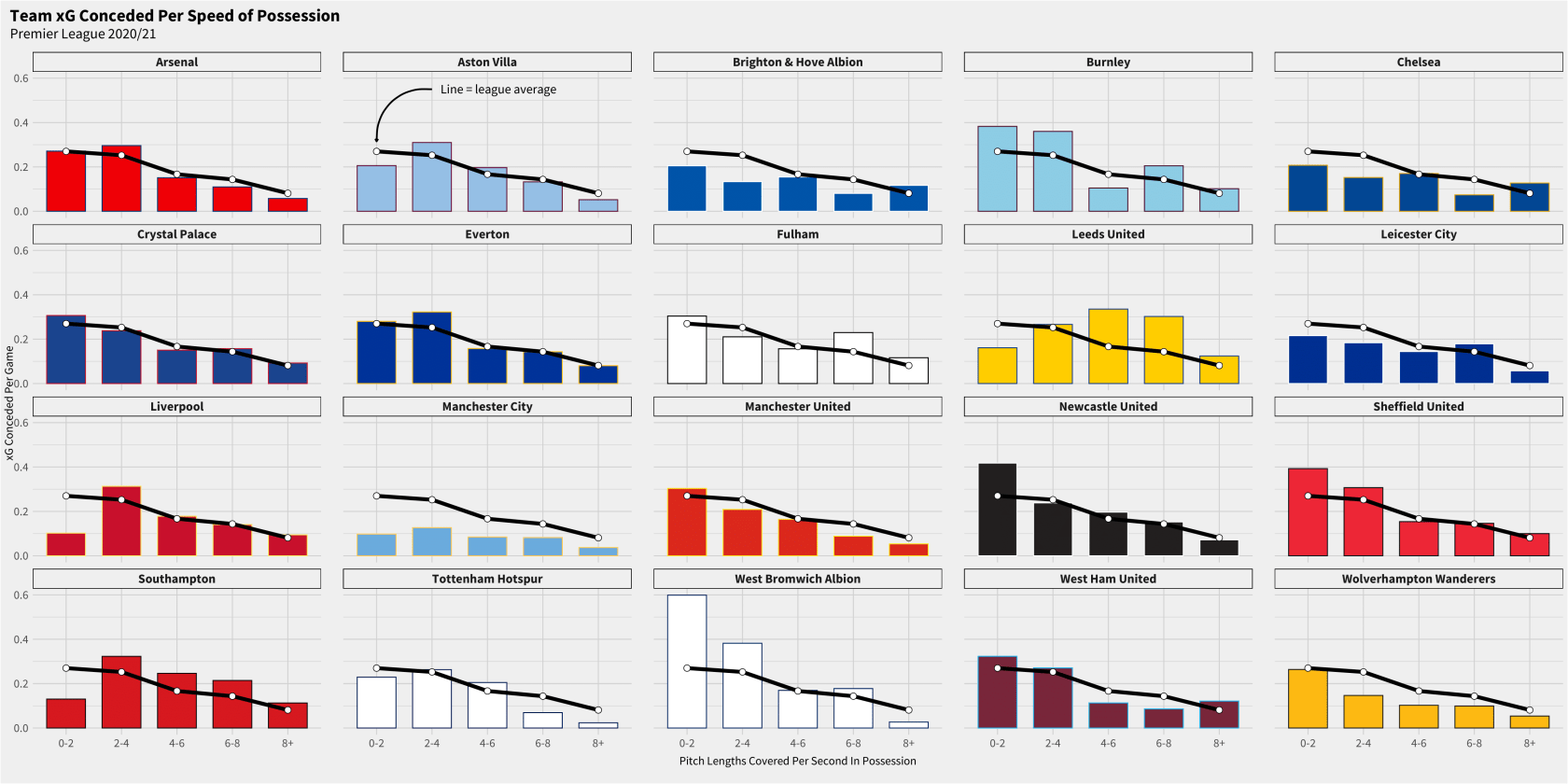
Still though, the ability to suppress shot quality helps limit the damage in the face of the relatively high shot volume they’re still allowing. It’s pretty admirable how sharp Villa are at key players getting back into position to close off options for attackers and to get in the way of shots, even given the raw volume they’re facing. Midfielders and wingers drop in to fill holes, defenders get in the faces of potential shot-takers. Where things get nasty is when the midfield or attackers are not able to get back and the defensive line just has to stretch itself to compensate. Some of their forward players are better at this than others. Bertrand Traoré and Trézéguet yes, Grealish, El Ghazi and Barkley less so (with some element of tactical instruction there – Grealish is their main out ball after all). Again, they do a good job in these situations of not totally losing their heads and the fullbacks particularly keep that narrowness. But, with their high line, sometimes things just end up going poorly.
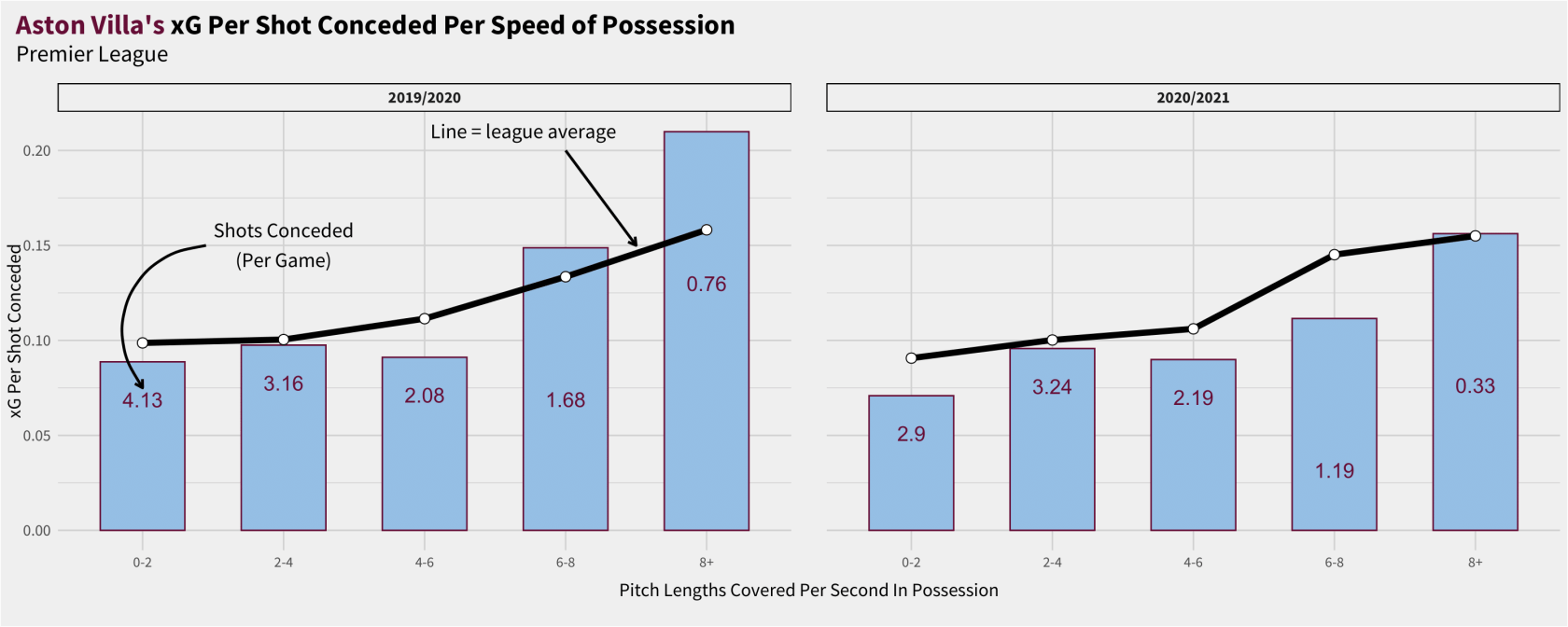
When does all go wrong, Martínez is there to save the day. He has been fantastic in net this season. One of the best in the league from a shot-stopping perspective.
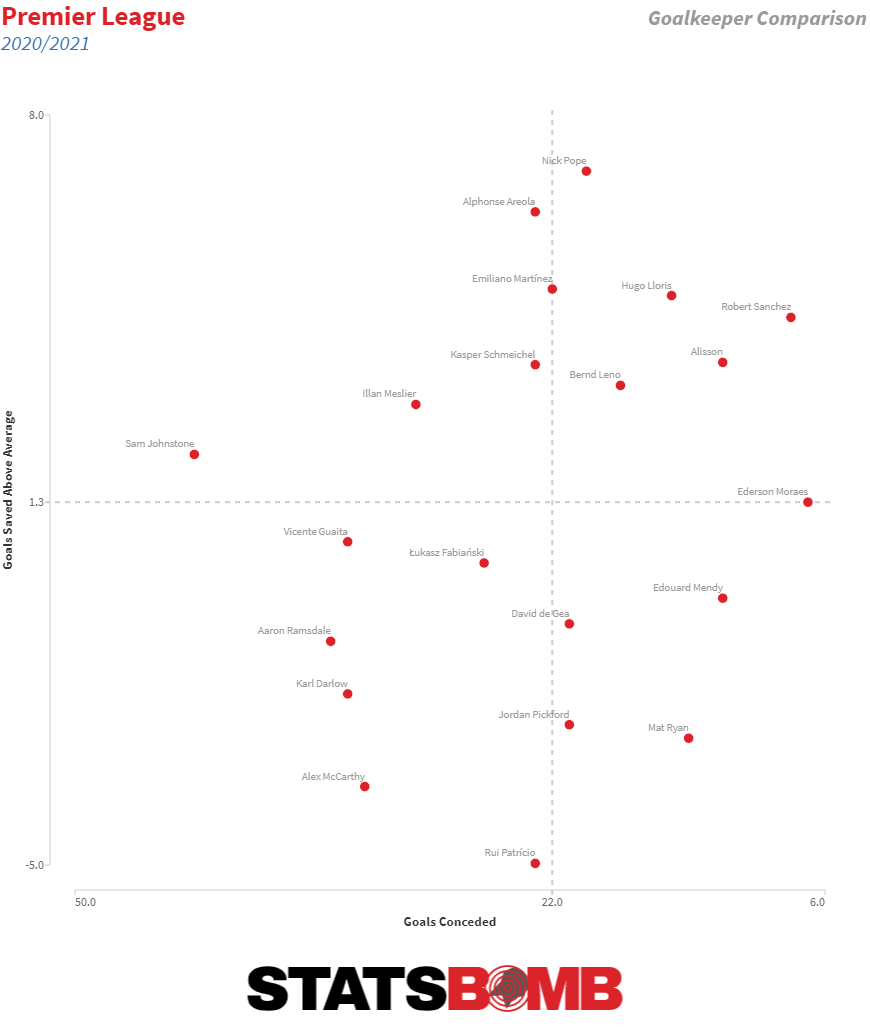
A sort of a side factor here is their penchant for shooting themselves in the foot via turnovers. They don’t turn the ball over close to their own goal often at all – remember, they’re getting it forward before they even have a chance to turn it over most of the time. When they do though, there’s a pretty decent chance the opposition will carve an opportunity from it.
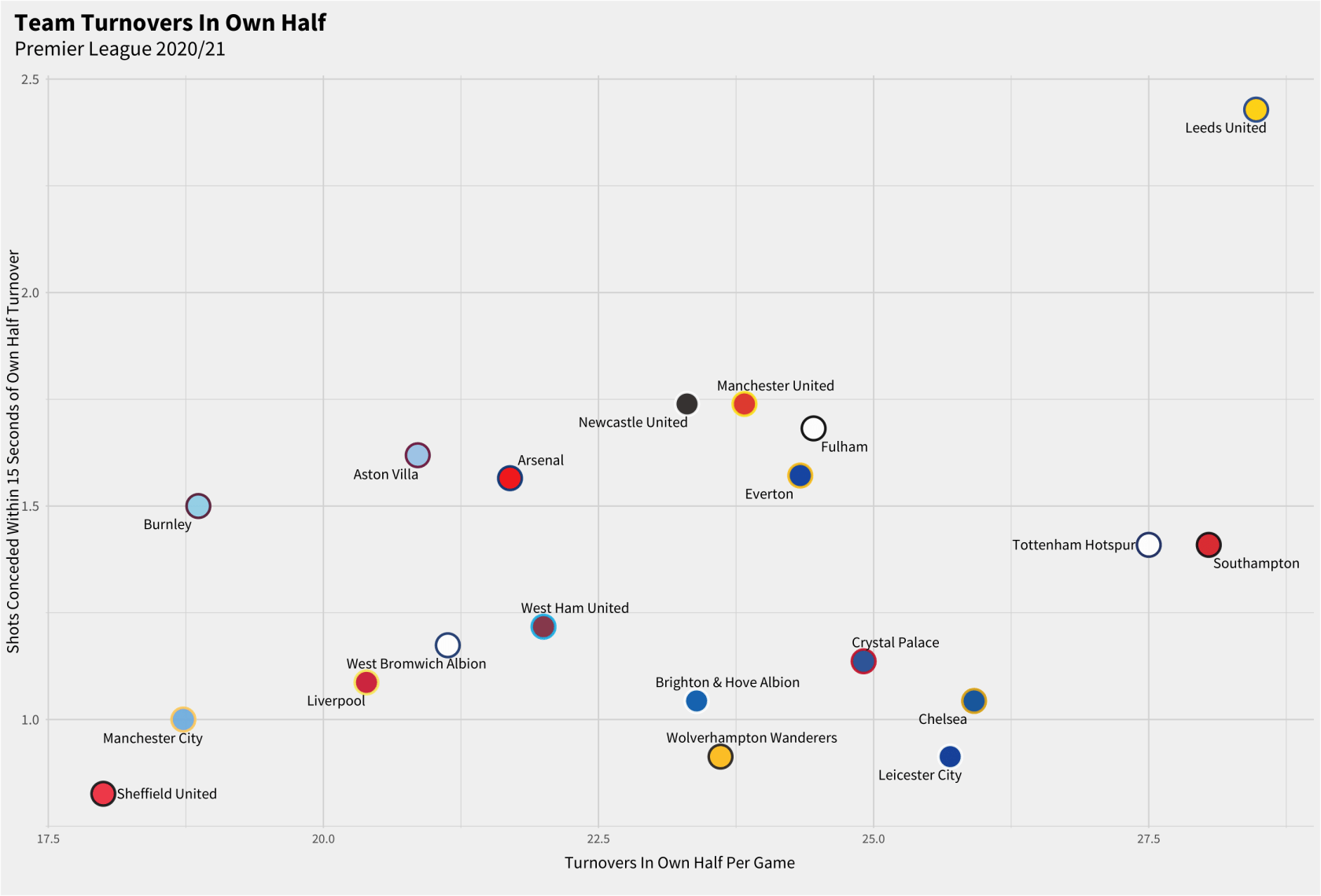
There is a bit of this being the natural consequence of their ‘get the ball, look forward’ mindset. A lot of hastily played passes and off-balance clearances. Ezri Konsa is one of the best centre backs in the league for completing passes under pressure, but Tyrone Mings is less so and Matty Cash equally is a wee bit iffy relative to position. Grealish also has a whiff or two in him, which is to be expected to some extent when so much goes through you.
How ‘real’ is all this then? It seems reasonable to expect that any team experiencing a drastic change in performances levels from one season to the next may drop off at some point. Such turnarounds just aren’t frequently sustained (hat tip to Leicester). We’ve already seen this to some extent with Villa. For a good many weeks they were up there in the top three best teams in the league in terms of underlying numbers, now they’re shifting anywhere from 5th-8th depending on the week. It’s close enough in this strange season that, in that chunk of teams after Man City and Liverpool, a game here or there can shift a team’s place up or down. All that said, we’re a bit over halfway through the season now and they’re still up there, so this is probably just their level. Pretty good!
There is at least one cause for pause though. We’ve emphasized enough that Grealish is doing a great deal for this team, so what if he’s injured for a serious amount of time? Other players can likely step up and individually take on a bit more responsibility than they need to right now, but that’s a lot of creative invention to replace. There’s also the possibility of a ceiling on the team’s level given how clear and narrow their patterns of play are. If they face a whole bunch of bunkering defences, do they have enough beyond Grealish magic to break them down consistently? That seems doubtful from what they’ve shown so far.
Now’s not the time to worry about that though. They’re a fun, relatively young team having an excellent season. Enjoy it while it’s here and hope it continues.
Post Script Notes (the part where I talk in first person):
- Many vizzes were made for this article. Many, many vizzes. Some that have been left out, along with all the ones that made it into the article, I have put into a public google drive folder here.
- You may be thinking “this is an article on StatsBomb written by a noted Set Piece fiend, why is there no discussion of Villa’s set pieces?” and the answer is, well, it just isn’t a very interesting story. They are high in both attacking and defending set piece xG, but the attacking side is pretty inflated by some unrepeatable oddities on free kicks (remember when Liverpool just didn’t move that one time?). Their set piece work in aggregate has largely little to say about it. There aren’t any wild designs nor amazing execution. They just have good deliverers and attackers of the ball, and they do solidly on that side of the ball. Namaste on that one.
- If you follow StatsBomb generally you’ve probably seen lots of promotion on Twitter and the like about ‘StatsBomb 360’. At the time of writing we don’t have that data ready in a form to slide into this article, but it has the potential to add a lot to some of the metrics I’ve had a go at here. I say this not in aide of promotion (I am also aware I am saying this directly above a big ‘STATSBOMB EVOLVE’ banner), it would genuinely just be a big boon in doing something like ‘receptions under pressure from behind’ or player positioning for second balls, rather than having to proxy it via traditional events. Maybe one to return to in future.
- Be well and have great days.
